An SEO strategy is an action plan designed to help improve a website’s rankings and increase organic search traffic.
It’s a detailed to-do list that will help you focus on the things that bring in more traffic and revenue from SEO.
In this post, we’ll show you exactly how to create and execute an effective SEO strategy, step by step.
Let’s get started.
Use our template to follow along.
Step #1. Benchmark Your Current SEO Performance
Benchmarking your current stats is the best way to start setting goals, tracking results, and analyzing what’s working and what isn’t.
As a baseline, you need to observe:
Organic traffic Keyword ranking BacklinksTogether, these insights give you a comprehensive picture of your site’s overall performance (historically and at present).
Organic Traffic
Organic traffic means how many visitors are coming to your website from organic (non-paid) search.
There are many ways to find your current organic traffic. You can use your favorite SEO tool or Google Analytics if you have it set up.
In this case, let’s see what it looks like using Semrush’s Domain Overview tool.
To start, enter your domain name, hit search, and click on the “Organic Search Traffic” tab.
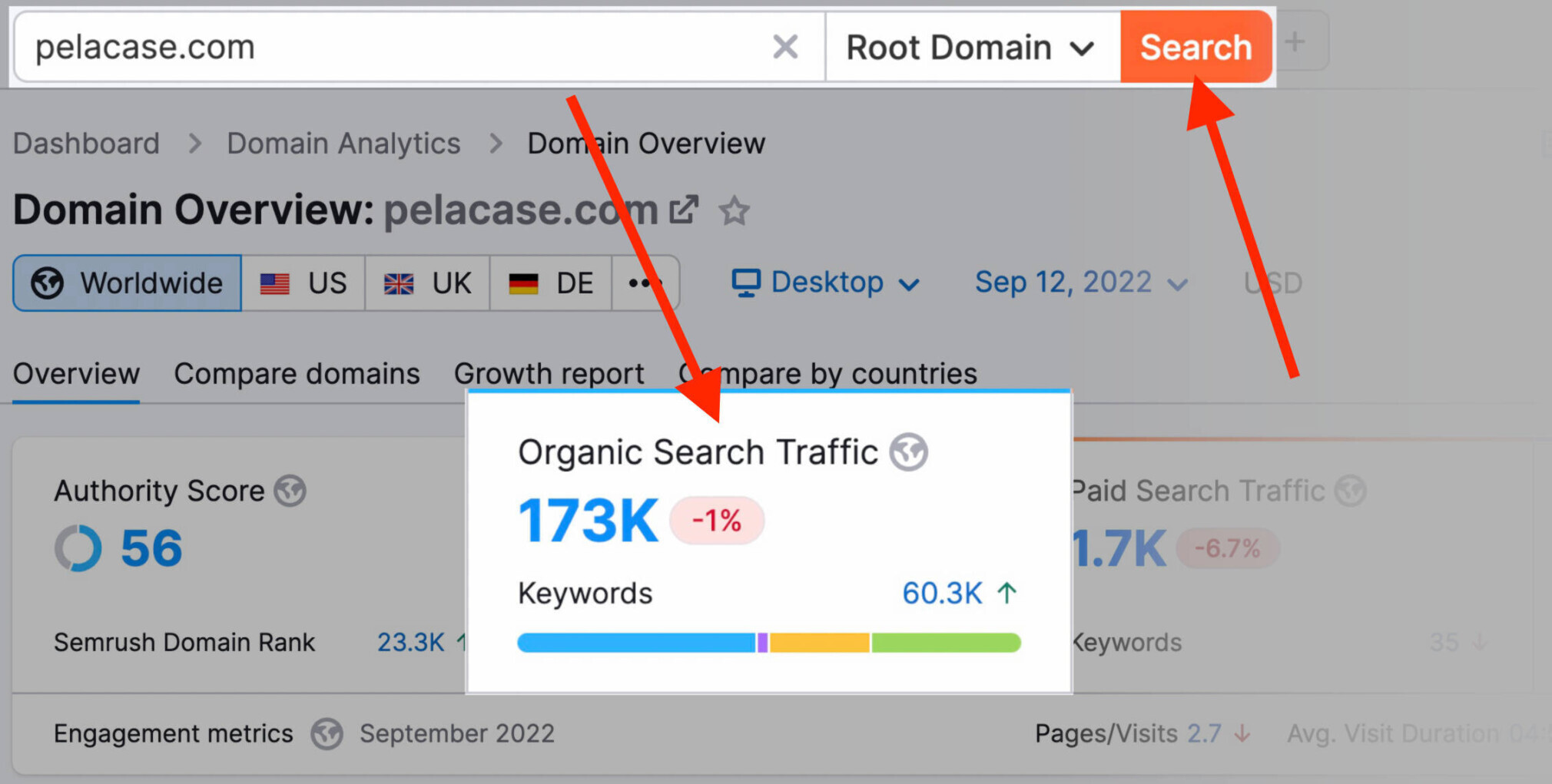
For example:
If we search for Pelacase.com, we see it brings in 171.4k visits per month from organic search.
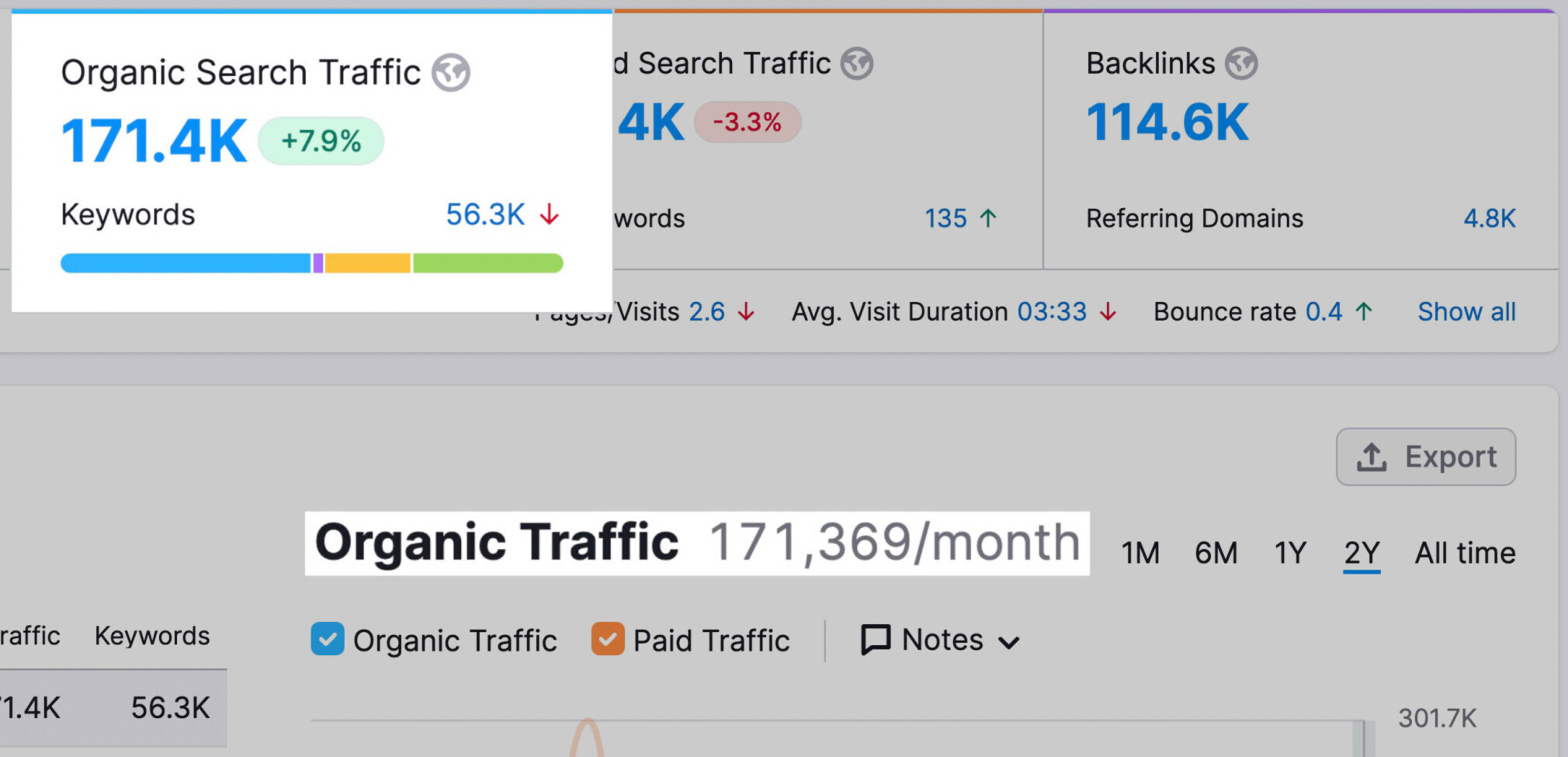
For the sake of this exercise, let’s benchmark Pelacase’s current organic traffic at 171.4k per month.
No need to export the full report for now, but do jot your organic traffic number down in the first step of the template.
Reminder: You can access the template right here.
Keyword Ranking
“Keyword ranking” is your website’s organic ranking in search results for a particular keyword. In other words, it’s how high your pages show up on Google.
Keyword rankings are important because higher-ranking pages get more organic search traffic.
In fact, the #1 organic result is 10x more likely (27.6% vs 2.4%) to receive a click compared to a page in the #10 spot.
You can find your keyword rankings in the same “Organic Search Traffic” screen. If you scroll down, you’ll be able to see your top organic keywords.
These keywords are the ones that generate the most organic traffic to your website.
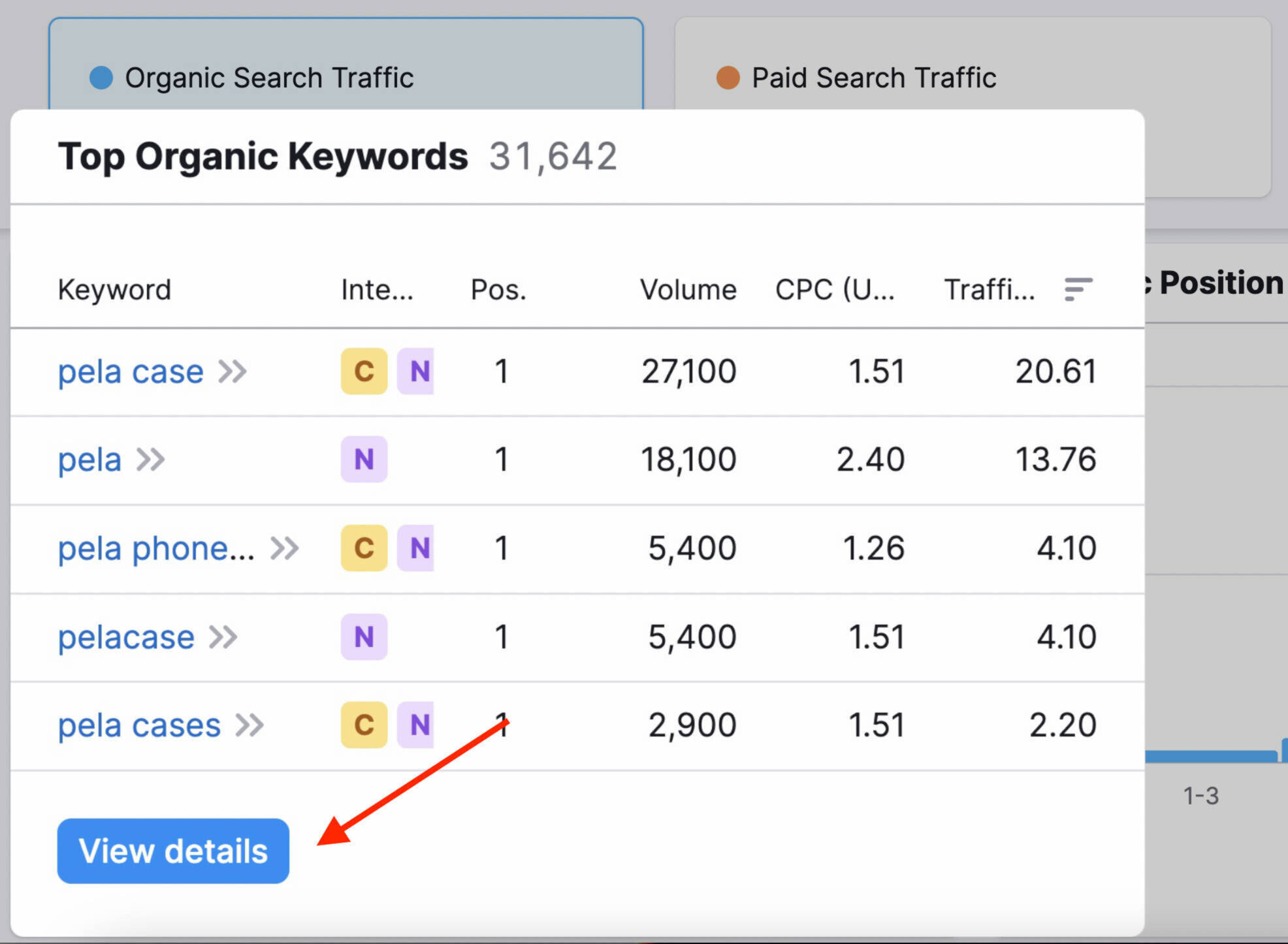
Click on “View details” to see more specific information.
Look for these four things:
The keywords you rank for Your ranking position for those keywords The search volume for each of those keywords (how many times per month people search for them) How much traffic they bring in
Take note of the top five organic keywords (and current position and volume) and write them down in your template.
Reminder: You can access the template right here.
We also recommend exporting a full report for your benchmarking records.
Backlinks
Next, check to see how many websites have links pointing to your site.
Websites with a high number of backlinks tend to have high organic search rankings.
Backlinks are like a vote of confidence. If many trusted sites link to yours, search engines can infer that it’s worth surfacing on the SERP (search engine results page).
Here’s how to see your backlinks with Semrush’s Backlink Analytics tool.
As soon as you input your domain and hit enter, you’ll see a dashboard with a number of important metrics:
Authority Score: A metric that estimates how easy it is for your site to rank, based on backlinks and other factors (higher is better) Referring Domains: The number of websites with at least one link pointing to your website Backlinks: The total number of links pointing to your websiteAnd more.
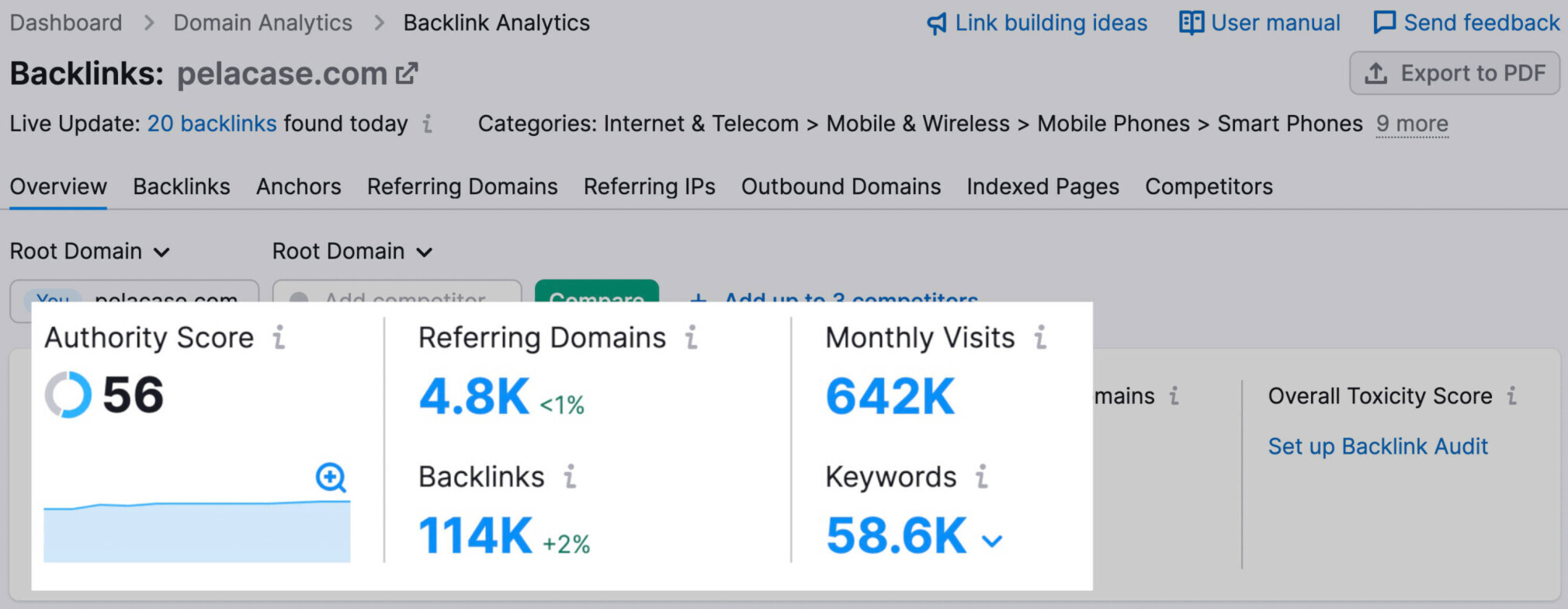
Take note of the current number of referring domains, backlinks, and monthly visits in your template.
Reminder: You can access the template right here.
Step #2. Analyze Your Competitors' SEO Strategies
You don’t have to guess which keywords to target, content to create, or links to build.
Instead, you can see what’s already working for others. And build upon that success.
Analyzing your competitors’ SEO strategies helps you:
Capitalize on your competitors’ weaknesses Replicate your competitors’ strengths Prioritize the most important SEO tasksLet’s see how to do that.
Identify Your Competitors
Start by identifying your main SEO competitors.
These are the websites that are competing for your desired keywords in organic search.
To find them, go to the Organic Research tool and enter your domain name.

Then, go to the “competitors” tab.

Scroll down to see a list of your top 100 organic competitors, the keywords you share, and their monthly traffic.
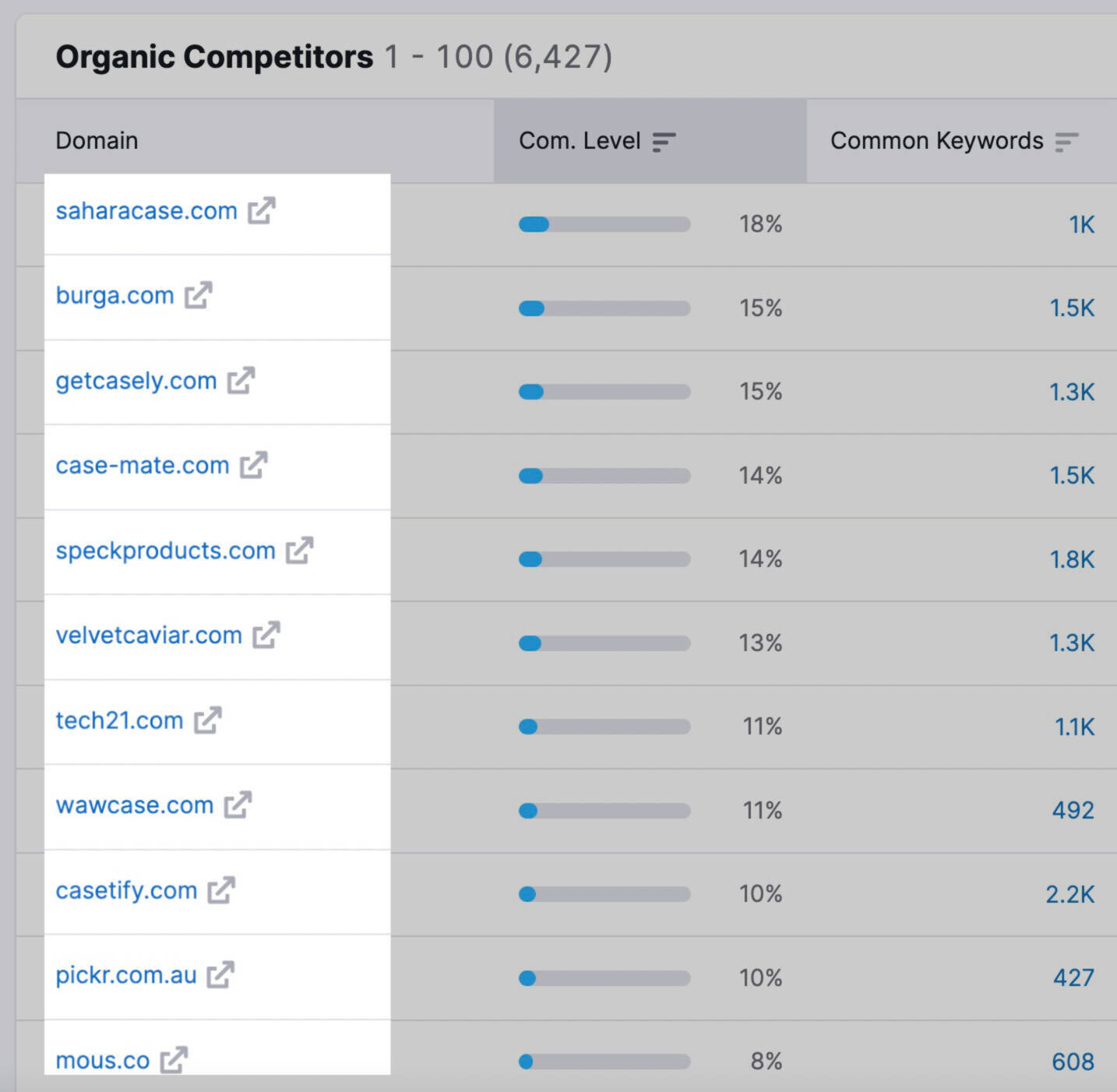
Look at the top 10 and identify the competitors that seem most relevant to your business.
Note: not all your direct business competitors will be your SEO competitors.
For example, imagine you’re a florist in a small town.
Your biggest local competitor is the other small florist down the road. But, they don’t even have a website. So, in terms of SEO, they’re no threat.
Log your top five most online competitors into your template doc and move on to the next step.
Find Your Competitors’ Valuable Keywords
Next, identify valuable keywords that your competitors currently rank for, but you don’t.
Each of those keywords is an opportunity for you to capture more traffic.
In Semrush’s Keyword Gap tool, start by entering your domain in the first “Root domain” field (on the far left), followed by your top competitors’ domains.

Hit “Compare” to see the keyword overlap (i.e., the keywords you and your competitors share and are battling for).
You’ll see the full list of keywords plus information about ranking positions, search volume, difficulty, and more.

Make note of your top five keyword opportunities in your template.
For a deeper analysis and better insights, we recommend downloading a CSV report and working with the data in a spreadsheet.
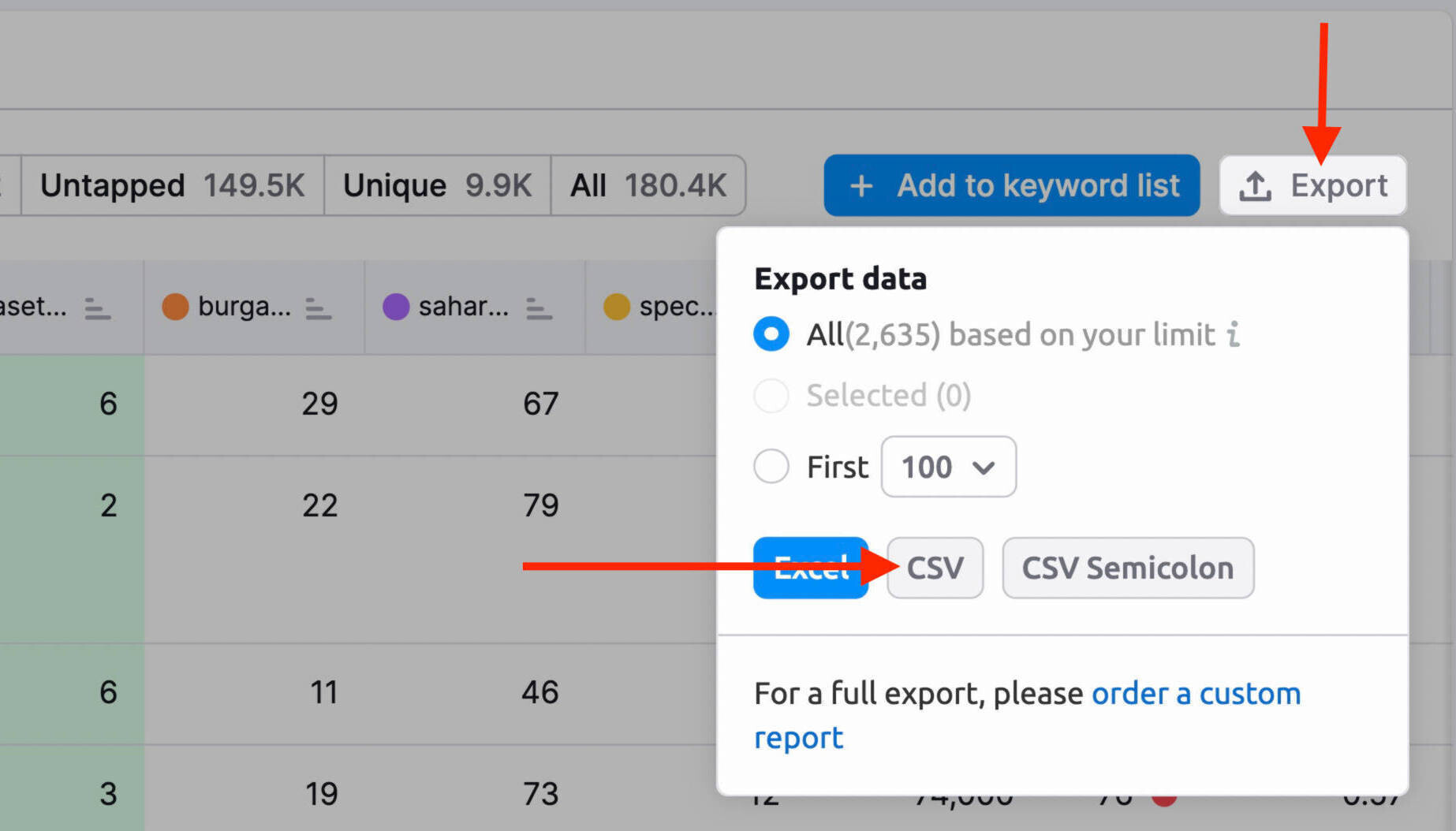
The CSV export contains a Keyword Difficulty column which allows you to find and sort for higher-volume keywords that are also easier to rank for.
Audit Your Competitors’ Backlinks
Backlinks are one of the most important pieces of the SEO puzzle. They represent a “vote of confidence” from one site to another. And you’ll likely struggle to rank without them.
A great tactic is to do a backlink gap audit to find websites linking to your competitors but not to you.
Why?
If they’re happily linking to your competitors, chances are they’ll be happy to link to you too.
This is especially true if you create even better content than your competitors.
Start by opening Semrush’s Backlink Gap tool.
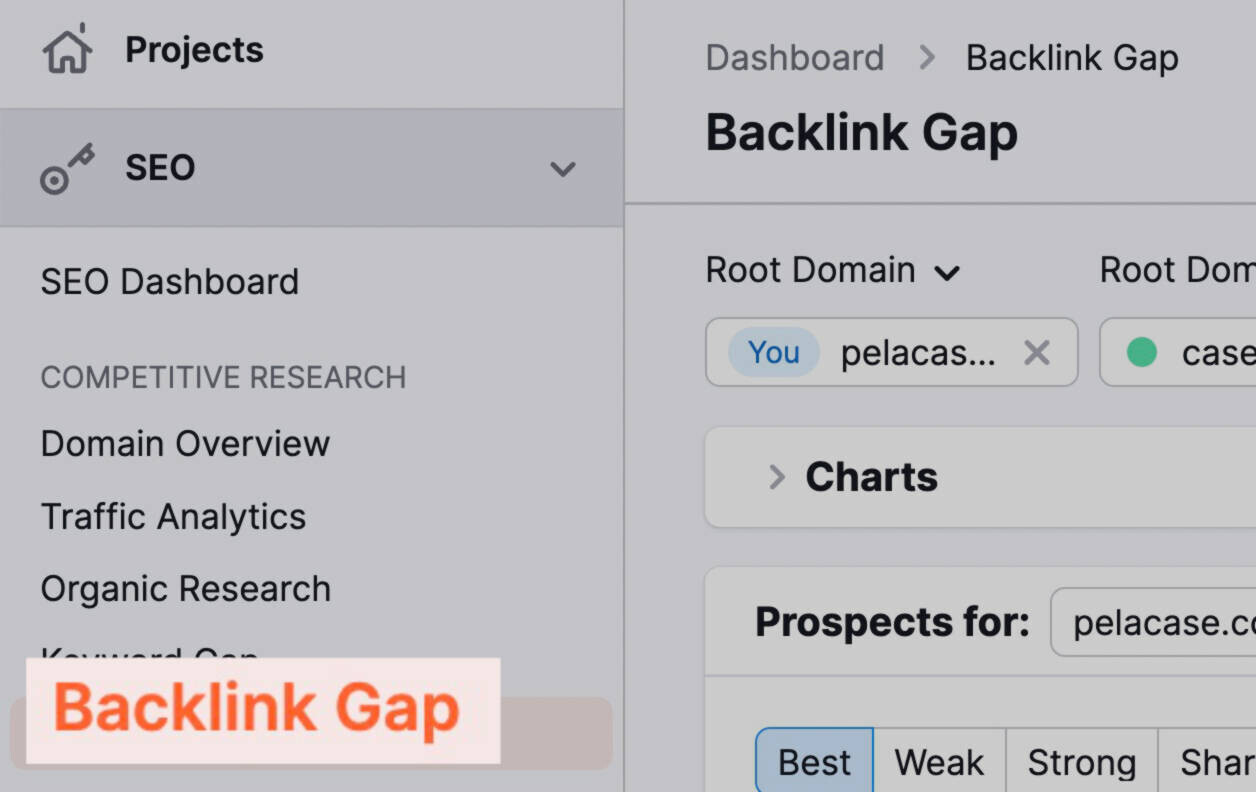
Then, add your domain, your competitors’ domains, and hit “Find prospects.”

The trend graph compares each of your competitors’ backlink profiles. It’s a quick way to see which competitor is earning the most backlinks.
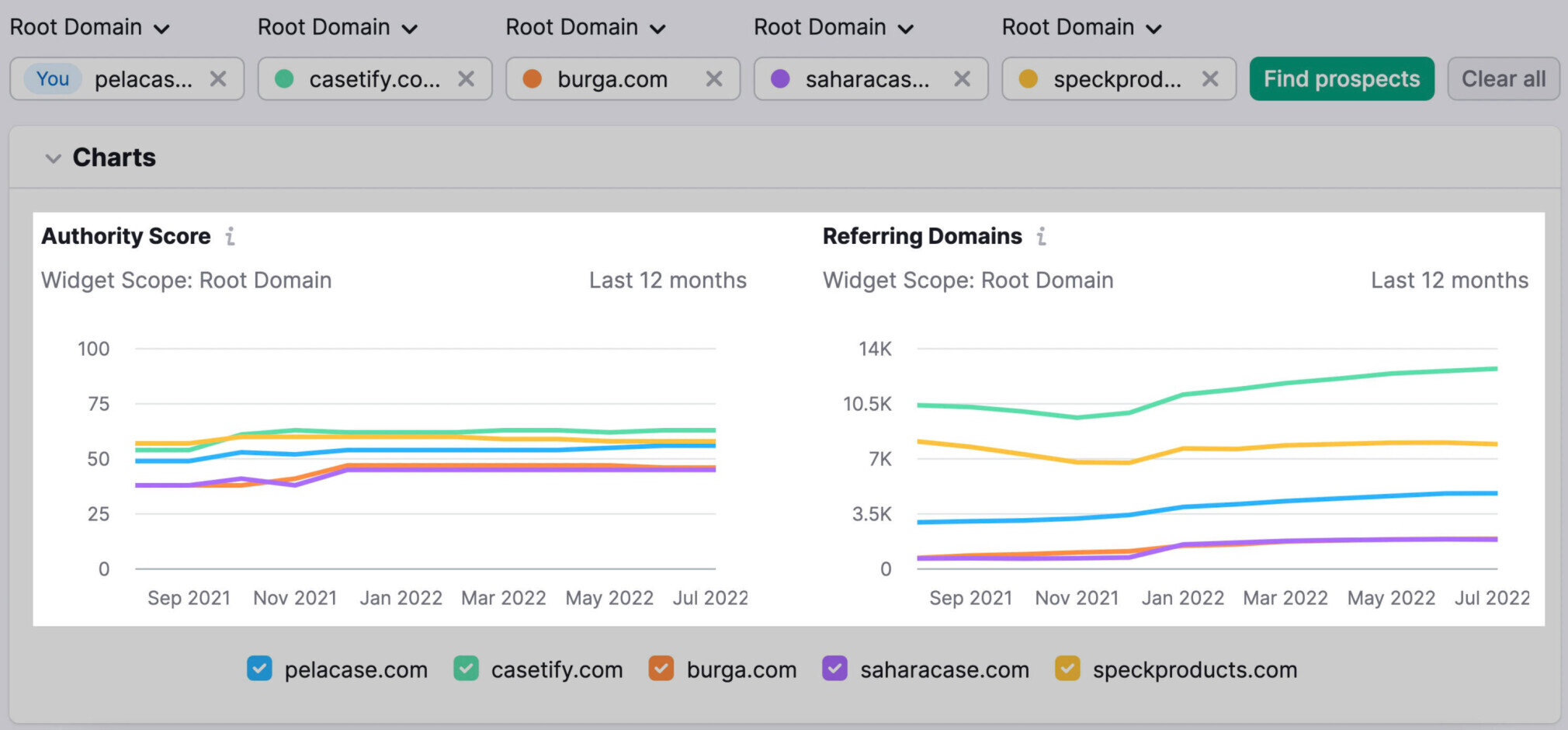
The table below the chart lists all the referring domains that send backlinks to the websites you entered.
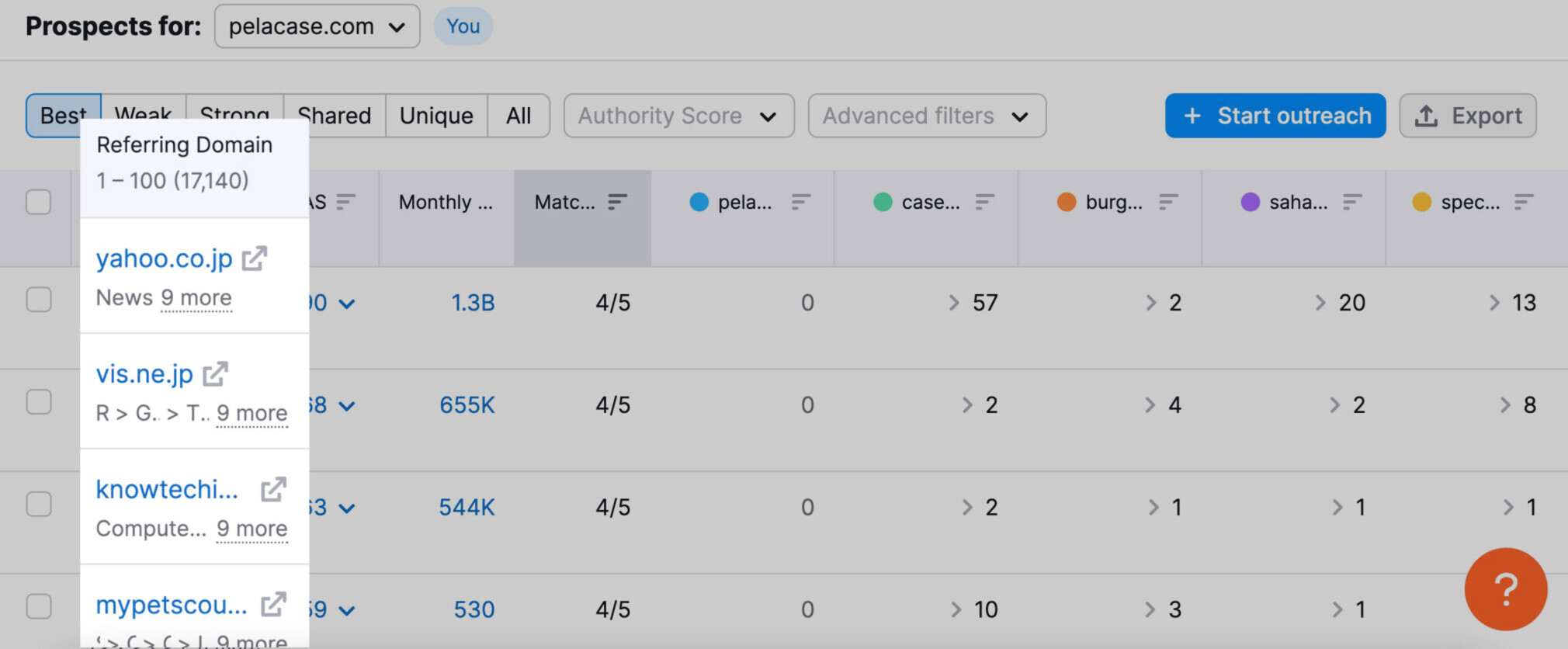
You can click on the drop-down arrows to get more specific information about the links and URLs from each referring domain to a competitor.
This will show the domain’s Authority Score, specific anchor text and target URL, the date the backlink was first seen, and more.

Export this report by clicking the “Export” button on the upper right corner of the page, and add it to your template doc.

Now you have a list of target websites you can reach out to for backlinks to your content. We’ll cover this step in more detail later on.
Step #3. Set Your Goals and KPIs
Setting goals and KPIs (key performance indicators) is one of the most important steps when creating an SEO strategy. It helps you evaluate success and determine if you need to make any adjustments.
Goals are the end outcome that you want to achieve.
KPIs are measurable values that help you track progress against your goals.
For example, your SEO goal could be to increase organic revenue by $100,000 over the next 12 months.
And your KPIs for this goal could be organic impressions, organic traffic, and rankings.
The right KPIs to track depend entirely on your goals and strategy.
Here are five KPIs you should keep a close eye on:
Organic traffic Keyword rankings Backlinks Average CTR (click-through rate) Coverage issuesWe’ve covered organic traffic, keyword ranking, and backlinks above.
Let’s examine the two remaining KPIs: average CTR and coverage issues.
Average CTR
Average CTR is the percentage of people that click on your site after seeing it on Google.
A higher CTR means more clicks and, therefore, more traffic.
But that’s not the only reason to track it.
Google also uses CTR in its ranking algorithm. A page that gets clicked more indicates that it’s relevant for that particular keyword and may be rewarded with a boost in rankings.
The easiest way to get this number is by using Google Search Console.
On the left-hand side, under “Performance,” click on “Search results.”
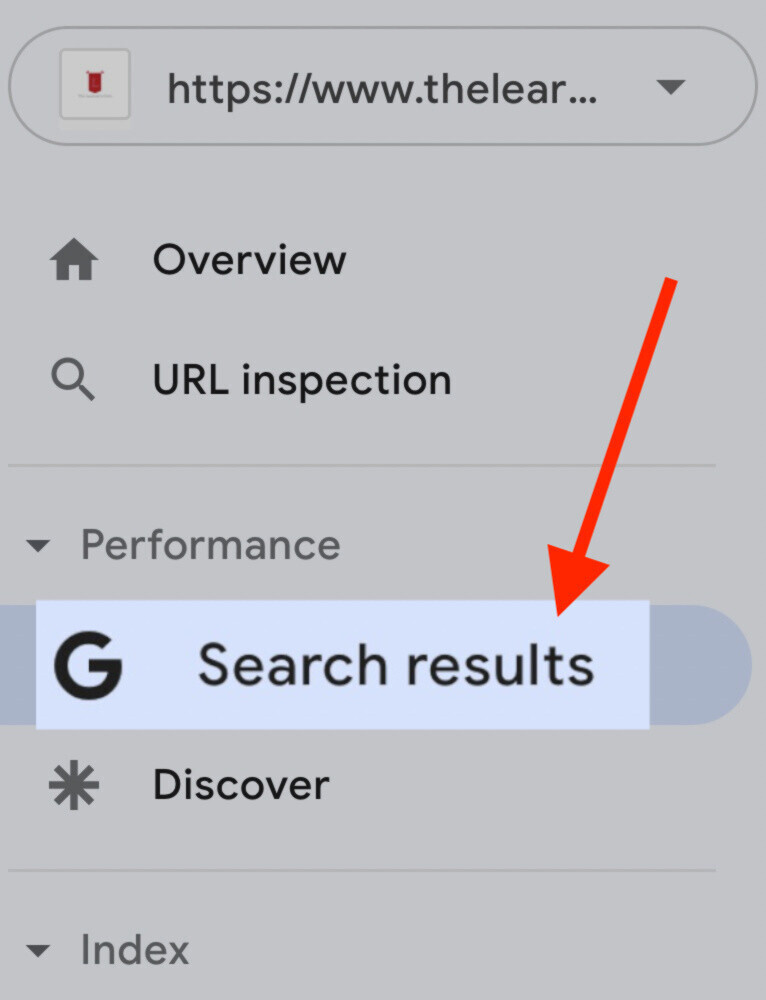
The next screen will display a dashboard showing your average CTR.
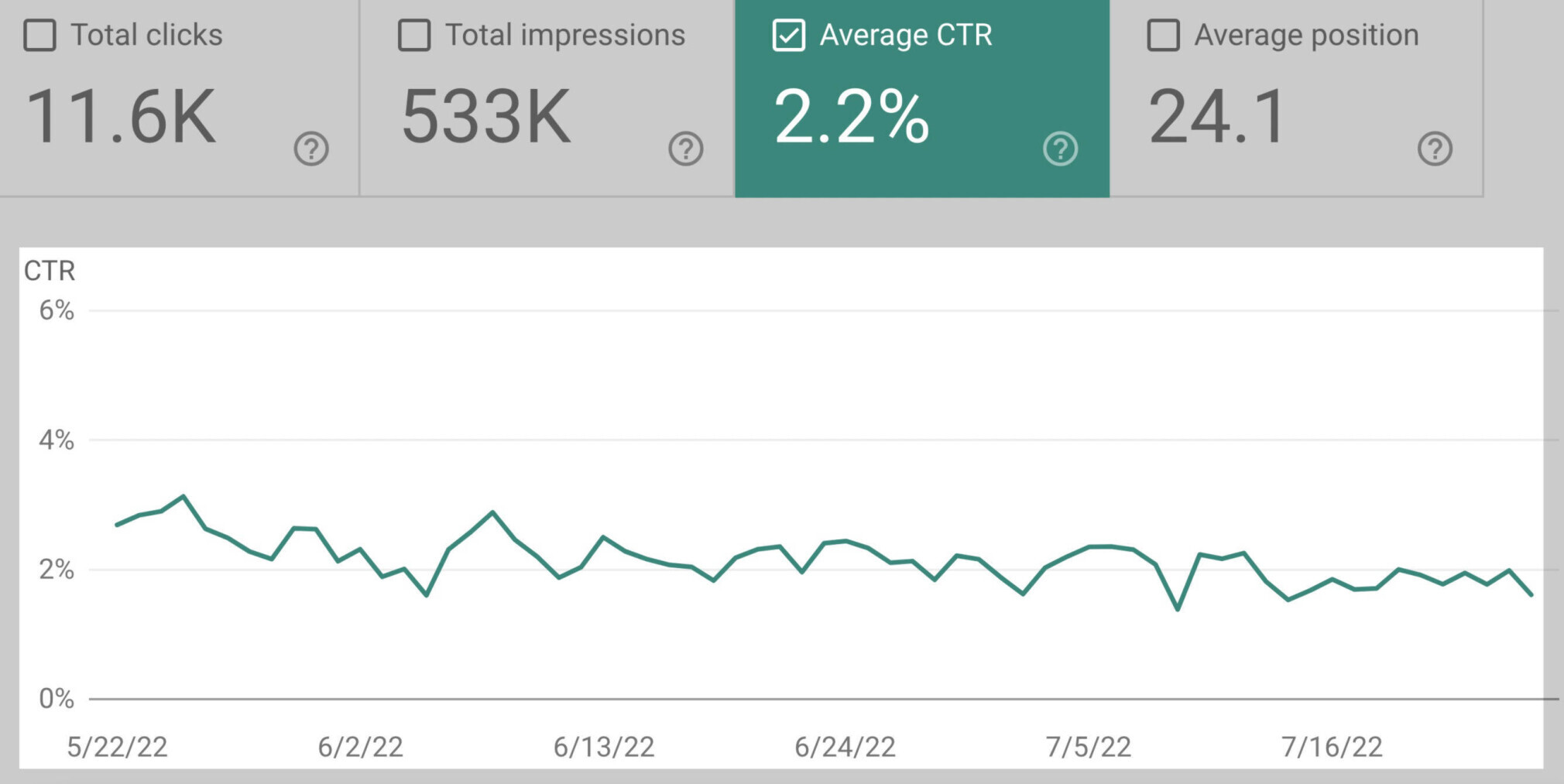
Add your current average CTR to your template doc.
Next, export your report so that you can track your CTR as you check up on your progress.
To do that, click on the “Date” option found at the top of the screen.
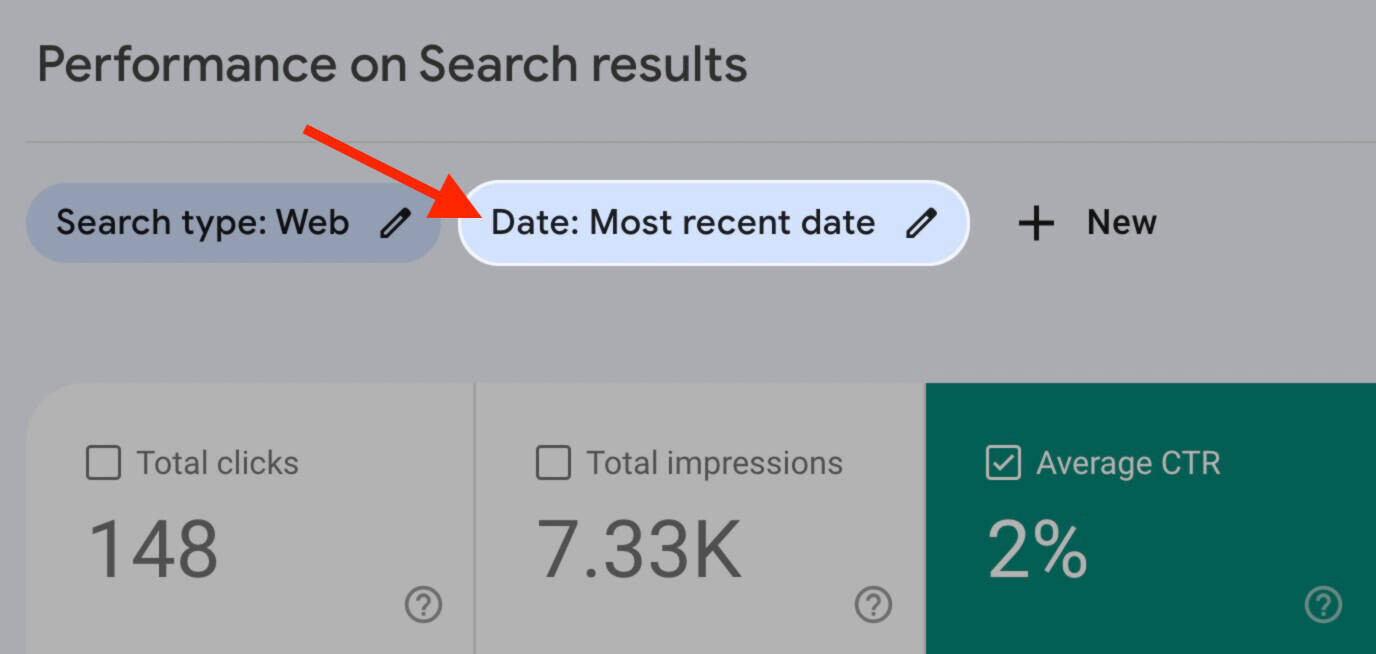
A pop-up with timeframe options will appear. Hit “Last 28 days” and click “Apply.”
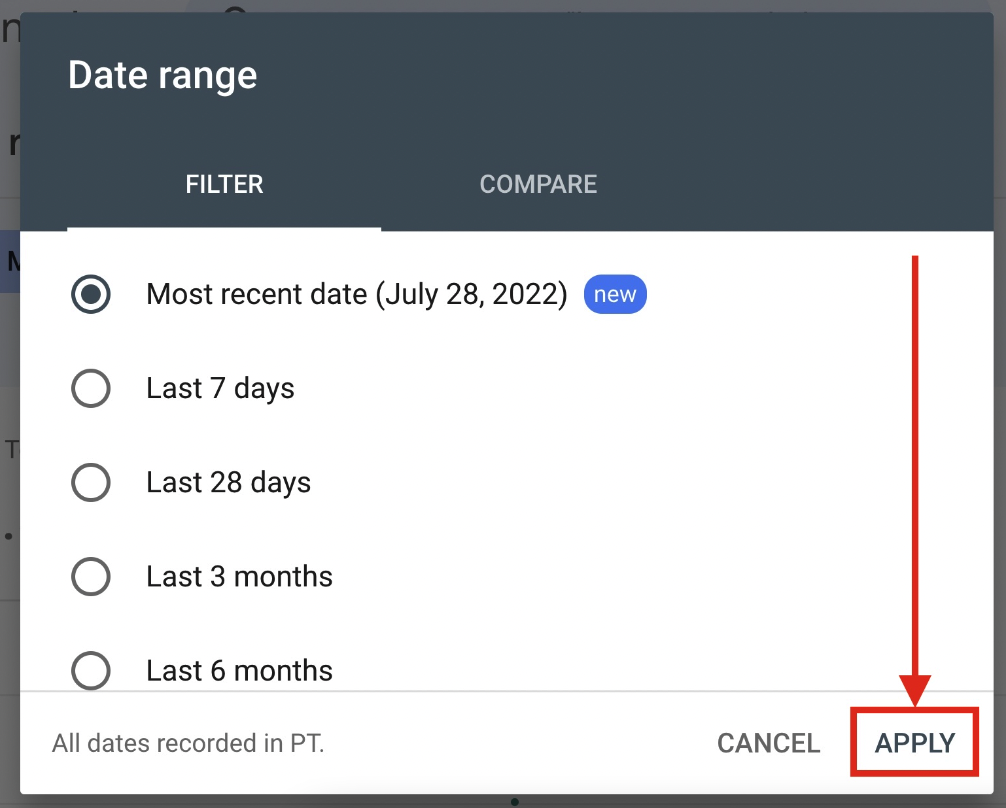
After which, hit the “Export” button on the top left corner of your screen. Save the file in your desired format.
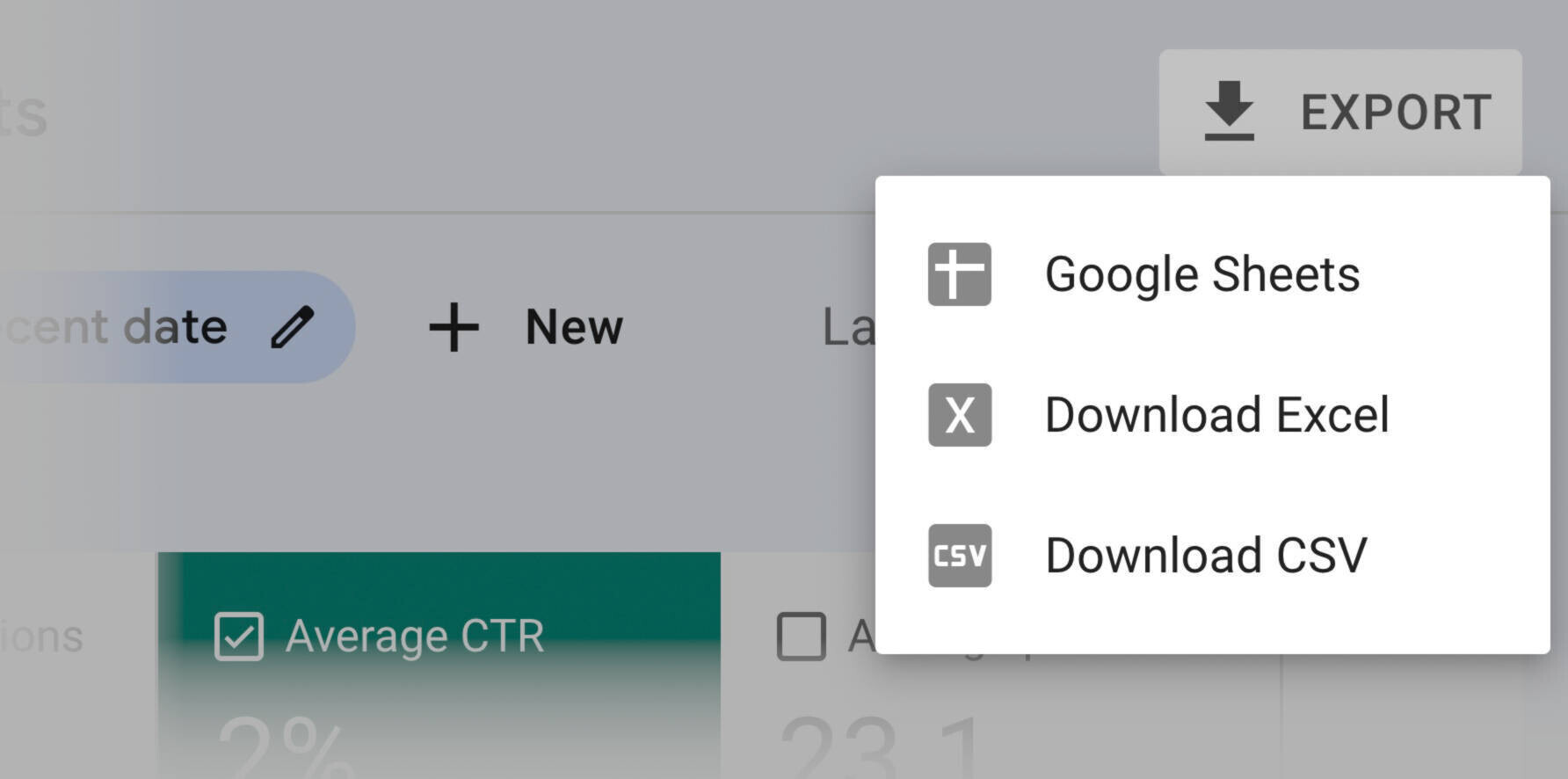
Coverage Issues
A coverage issue happens when a search engine tries to reach a page on your website but fails.
For example, 5xx server errors, 4xx errors, duplicate URLs, noindexed pages, etc.
Crawling and indexing problems with your site are called coverage issues or errors.
Regularly tracking these issues as a KPI is important because error pages aren’t indexed. Indexing is Google’s process of storing web pages in its database to then show in search results.
If your pages aren’t indexed, they’re not going to rank for anything.
You can find your Coverage issues under Index -> Coverage in Google Search Console.
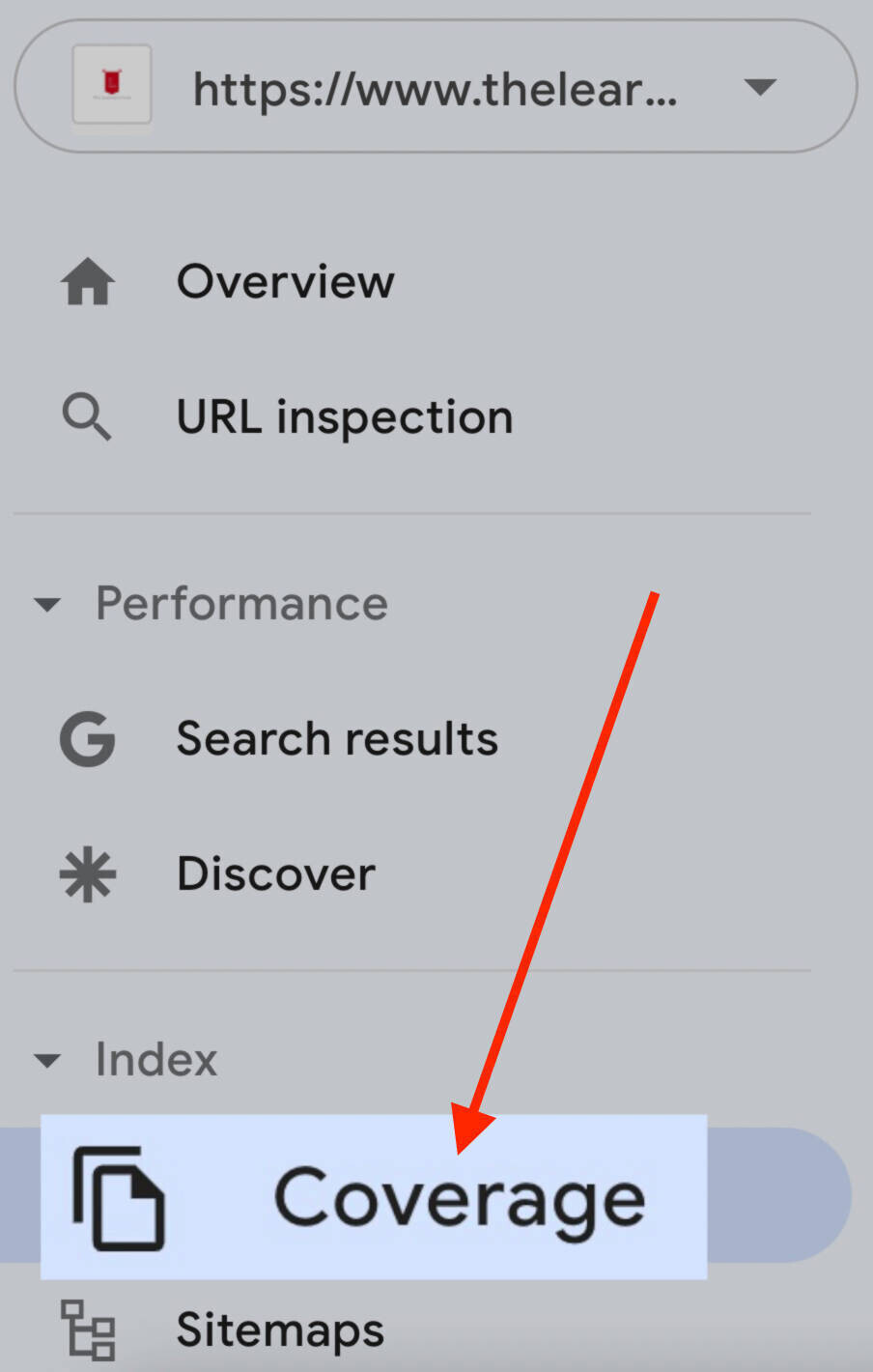
You’ll see a summary of the errors, warnings, valid pages, and excluded pages.
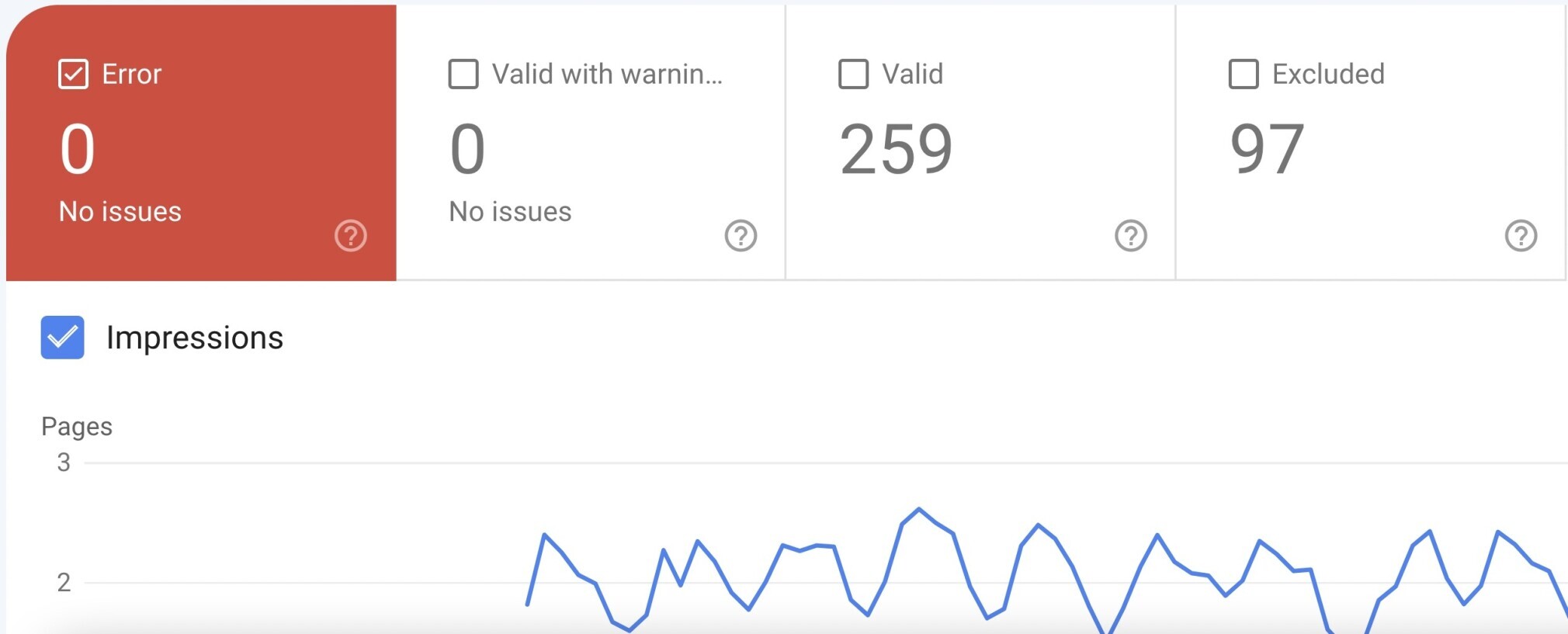
Scroll down to see details about each error or warning.
For example, in the screenshot below, you can see the type of error, validation status, the trend, and the number of pages with that error.
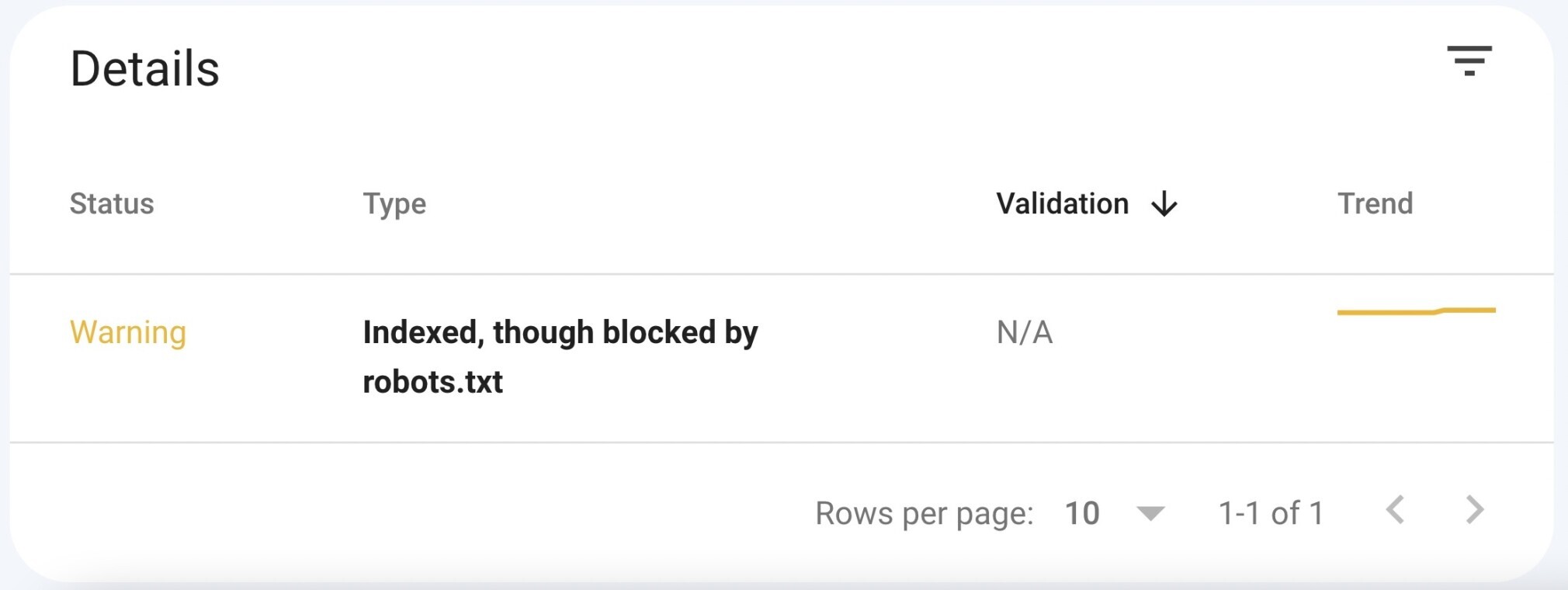
For further reading, here’s a comprehensive guide on fixing all kinds of crawlability issues.
Step #4. Audit Your Site's Existing Content
A content audit is the process of analyzing your content to find opportunities for improvement.
This step is important for understanding what you need to do to improve your site’s SEO performance. It helps you identify pages that aren’t performing well, why they aren’t, and how to fix that.
Here’s how to perform a content audit.
Find Low-Performing Pages to Delete or Redirect
Your first step is to find the low-performing pages on your site and remove, redirect, or optimize them.
These pages are likely not generating traffic or sales, so addressing this issue is your top priority. Low-quality content is a major indicator to search engines that what you’re providing isn’t good enough.
You can easily find poor-performing content using Google Analytics.
Start by heading over to “Site Content” –> “Landing Pages.”
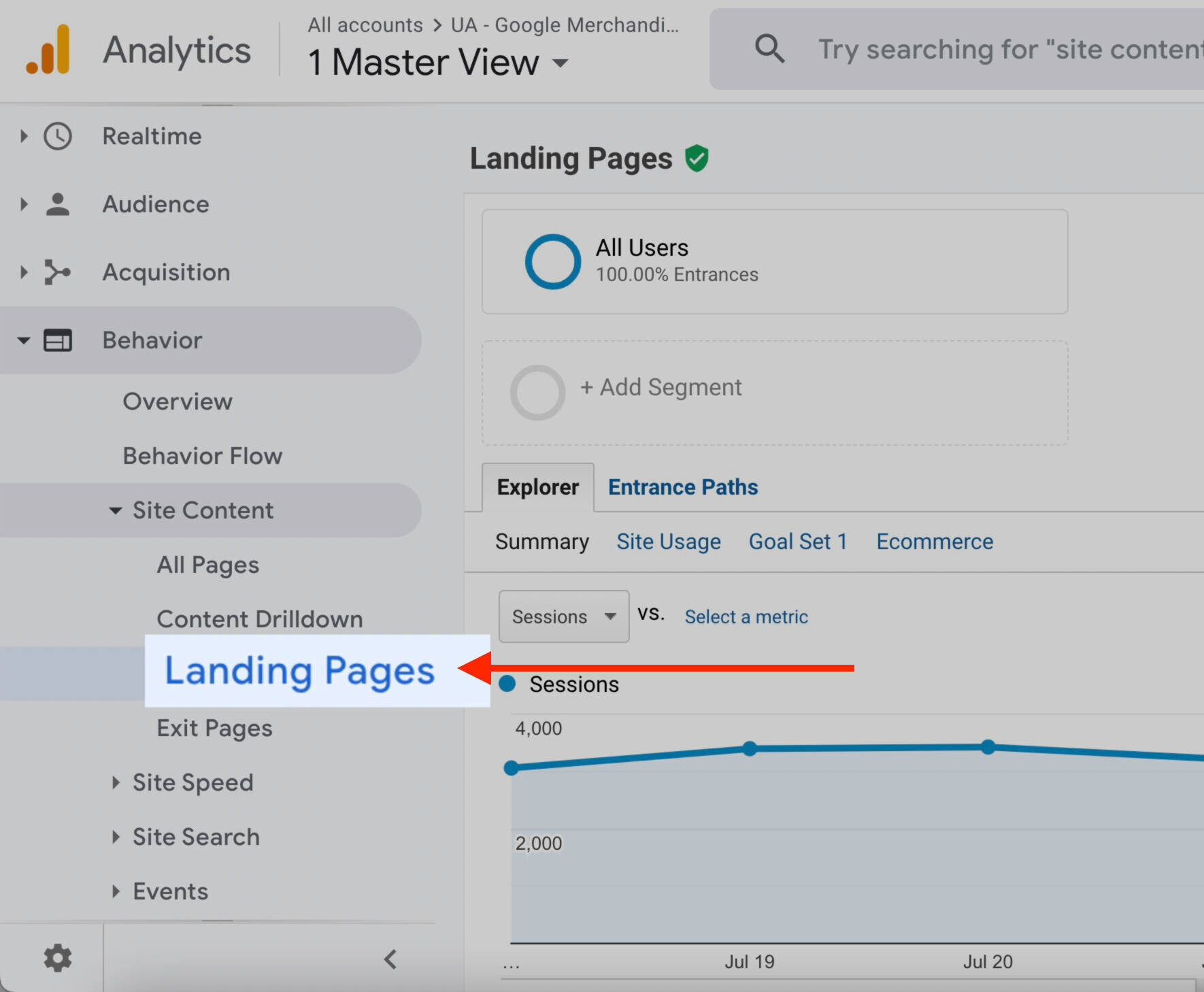
And then sort your landing pages by the least amount of sessions.
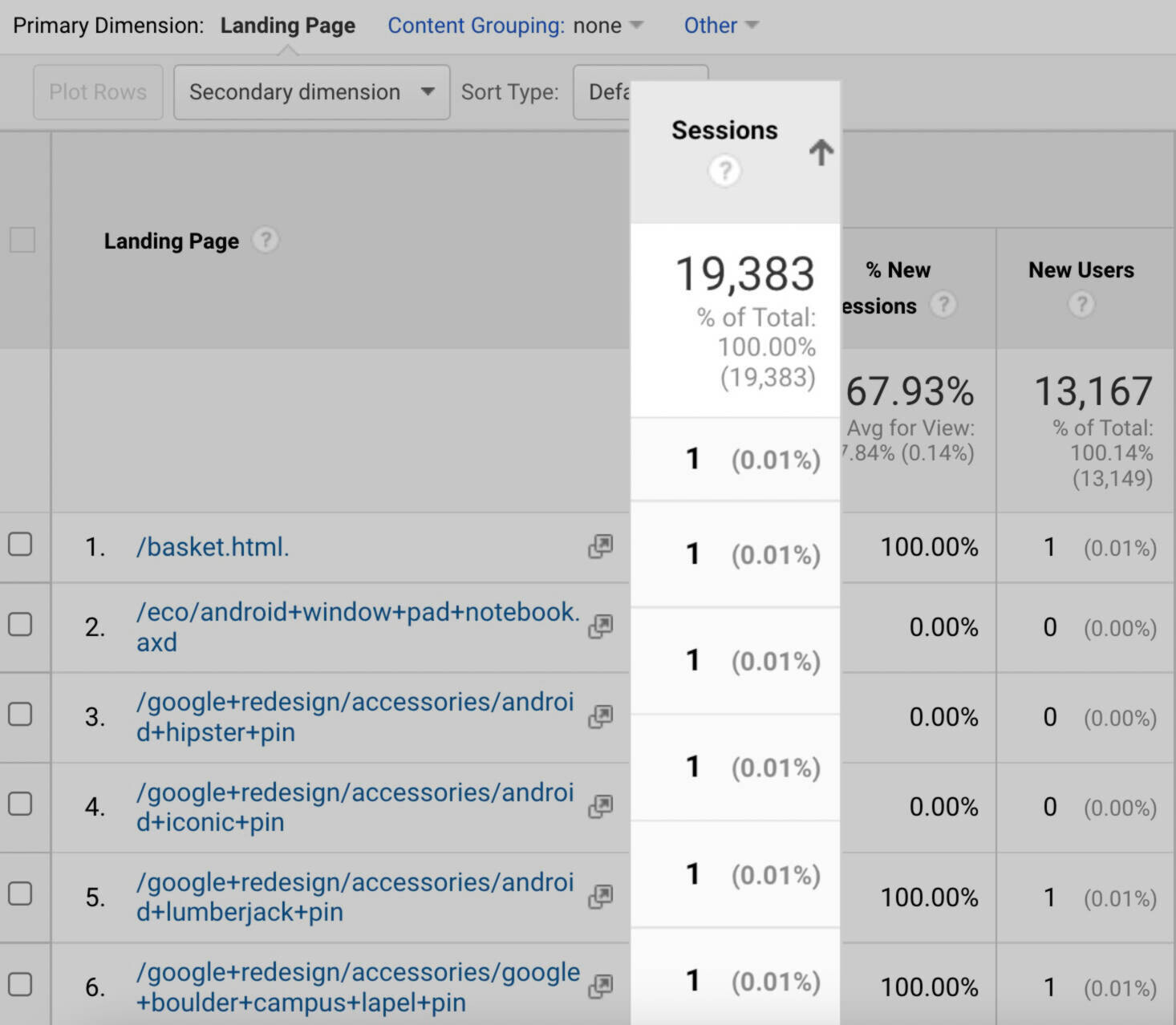
Note: If you’ve published lots of content on your site, there will be a lot to sift through.
As you make your way through the list, locate content that brought in only a handful of visitors over the last month (ignore well-performing content).
Once you’ve identified these pages, your next step is to either:
Delete the content outright Optimize it or combine it with another piece of content on your site 301 redirect the page to a similar page on your site Merge multiple pieces of content into one postThe “right” course of action depends on the content itself.
For example, if you wrote a blog post about an event from five years ago, you’re probably better off just deleting it.
But, if you have a post that’s solid overall but lacks depth and usefulness, that’s a case where you might want to combine it with another piece of content or optimize it.
Evaluate Your Content Based on Traffic
Now that you’ve either deleted, merged, or redirected your worst-performing content, it’s time to work on what’s left.
Specifically, you want to evaluate your content based on one objective metric: traffic.
Traffic is an objective number that reflects whether or not a piece of content is doing its intended job (SEO-wise).
For this example, let’s use Semrush’s Organic Research tool.
Enter your domain, hit search, and go to the “Pages” tab.
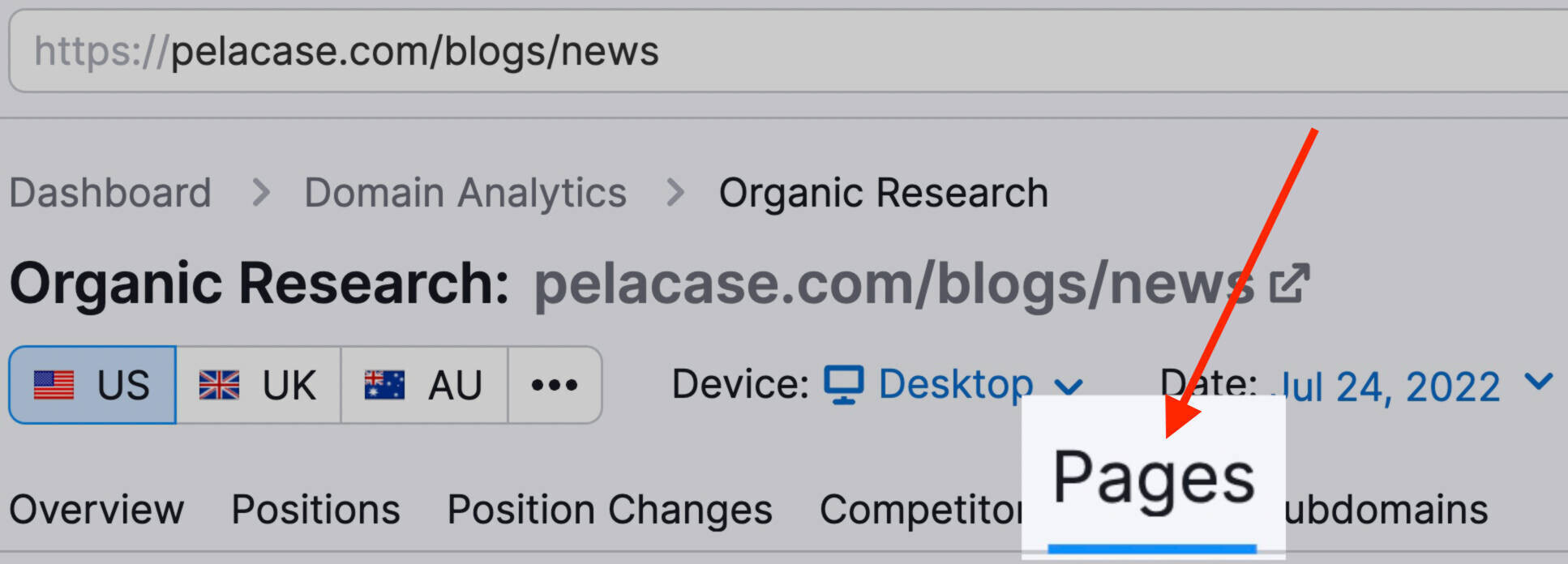
You’ll see a list of all your organic pages.
Click on “Traffic” to sort them by the amount of organic traffic they bring in.
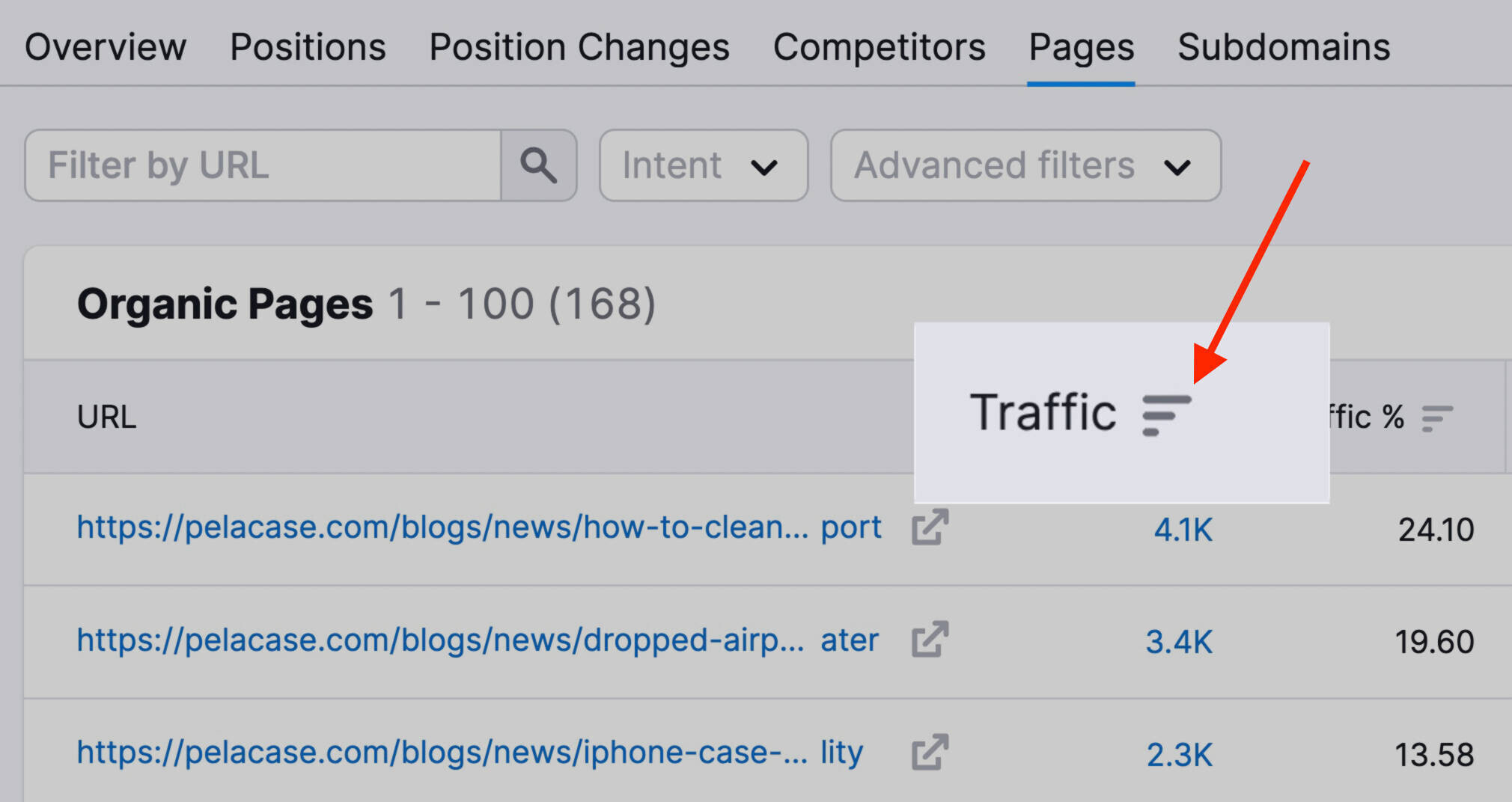
Export this list and add it to your template doc.
You now have a practical resource to help you identify content that’s not working well and prioritize next steps.
Note: There’s no industry benchmark for a good “Traffic” metric, so base it on your overall performance to see what’s working well for you.
Improve & Relaunch
Now it’s time to improve your existing content.
There are many ways to make your content better, but here are a few approaches that work well and apply to most content types.
Add Visual Elements
If your content is 100% text, consider tossing in a few pieces of visual content in your post, like graphs, charts, and infographics.
These add visual breaks and help to simplify complex concepts or processes, which improves the reading experience.
Update Everything
Find and replace dead links, old images, and update the content itself to reflect changes in your industry.
This way, everything works as intended, your content is up to date, and your on-page SEO is in order.
Make It Easier To Read
Old content isn’t likely optimized for the mobile user experience.
Prioritize improving your content readability on smartphones and tablets to improve accessibility and remain competitive.
Cover More Ground
Consider turning a post into an ultimate guide covering an entire topic in-depth.
This isn’t about inflating your word count. It’s about ensuring your content gives readers a complete answer to their problem or question.
If you want to dive deeper into conducting a content audit, read our step-by-step guide.
Step #5. Build Out Topic Clusters
Topic clusters are groups of interlinked pages about a particular subject.
They’re important because they help search engines understand the hierarchy of your website and validate your authority around a specific subject.
It consists of three components:
A “pillar” page focused on a topic A “cluster” of pages covering related subtopics in more depth Internal linking between all the pages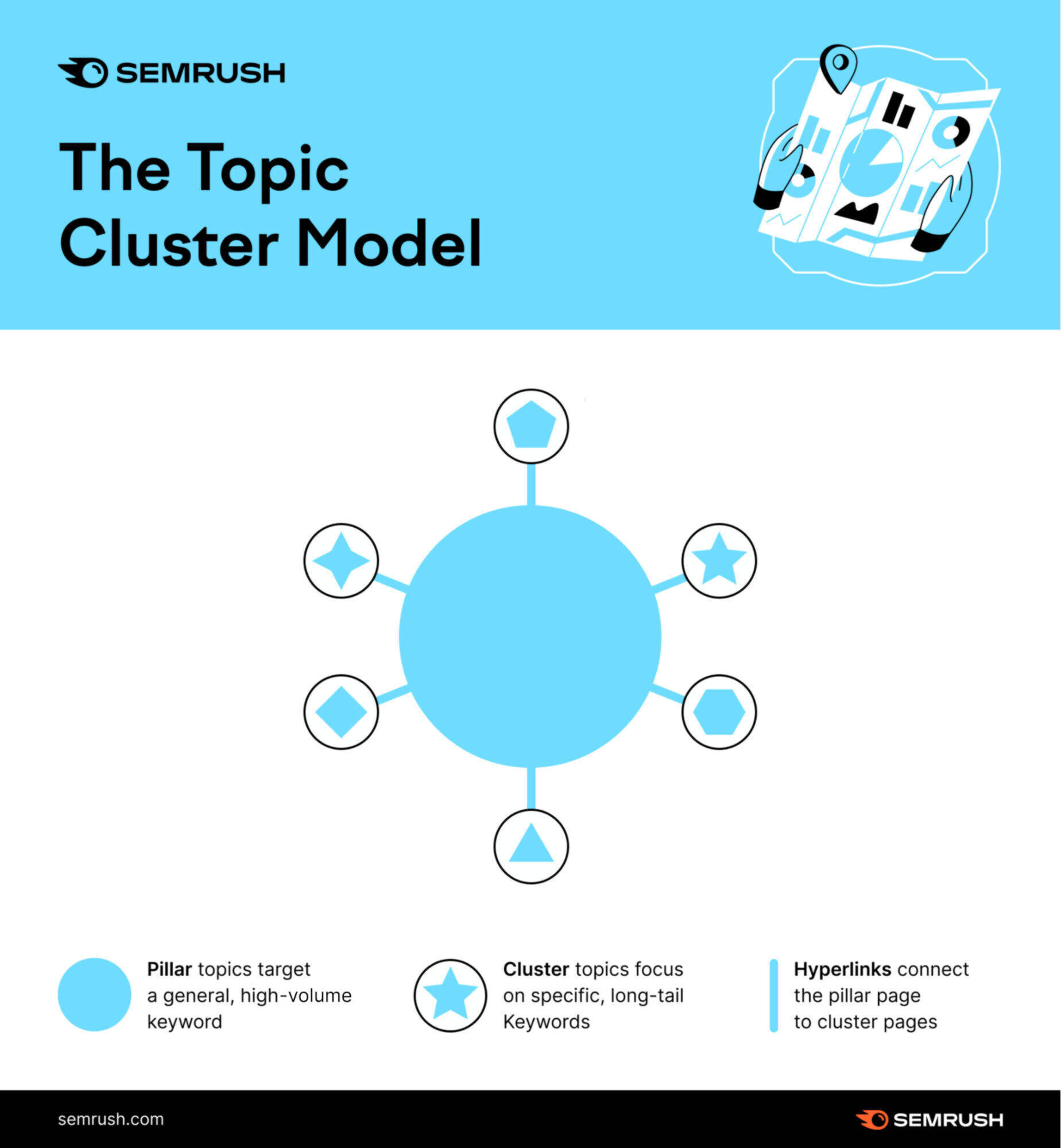
Nail these three elements, and you have yourself a topic cluster.
Here are three simple steps to get you started:
Choose the topic you want to rank for Conduct keyword research Group subtopics with similar intent1. Choose the Topic You Want to Rank For
Before building a cluster, you need to pick a topic (pillar).
It needs to be specific enough to focus on a single concept but broad enough so that you’re not limiting the amount of content you can create.
For example, a pillar topic can be “SEO copywriting,” and cluster topics can be “SEO writing tools” or “how to write SEO content.”
The key is to start thinking in terms of topics and not just keywords.
If you’re struggling to find ideas, head over to Semrush’s Topic Research tool and search for a term related to your industry.
We’ll use “copywriting” as our topic (or pillar) for this example.
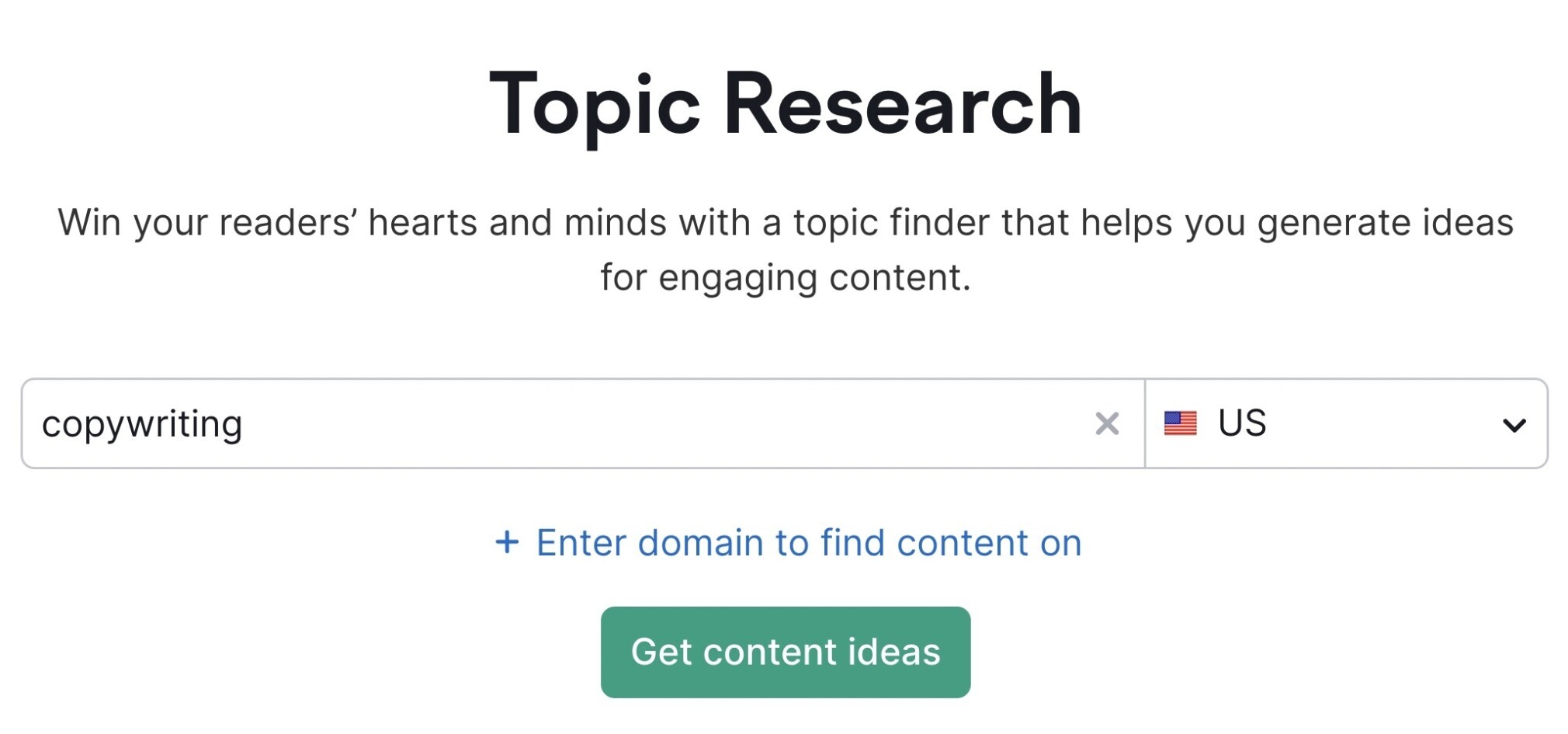
Once you enter your topic and click on the “Get content ideas” button, the tool generates a list of potential subtopics in the form of cards.
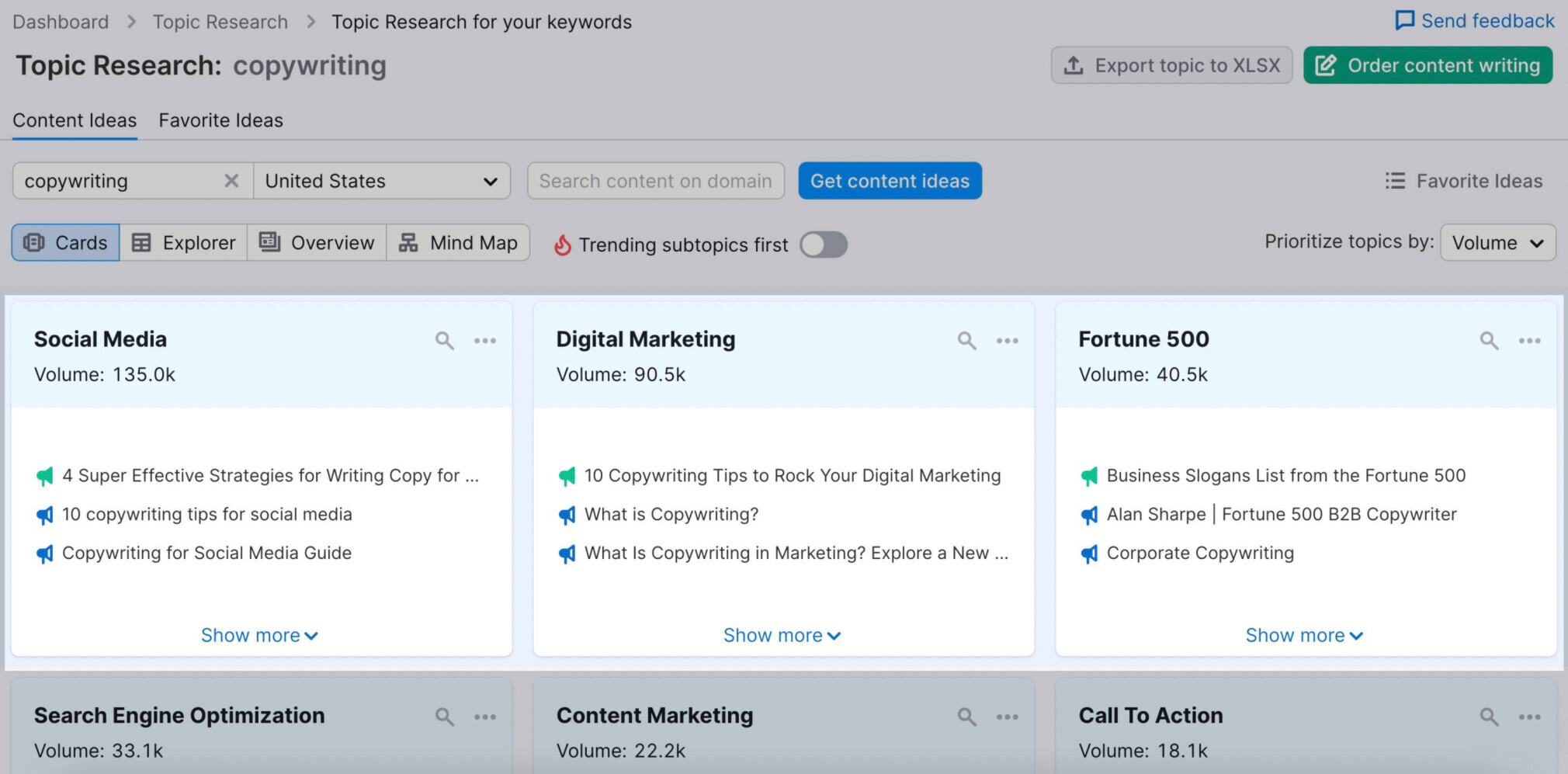
If you click on a card, you’ll see more information like the top headlines, questions around the topic, and related searches.
This is a fantastic way to get the juices flowing and gather ideas for your content.
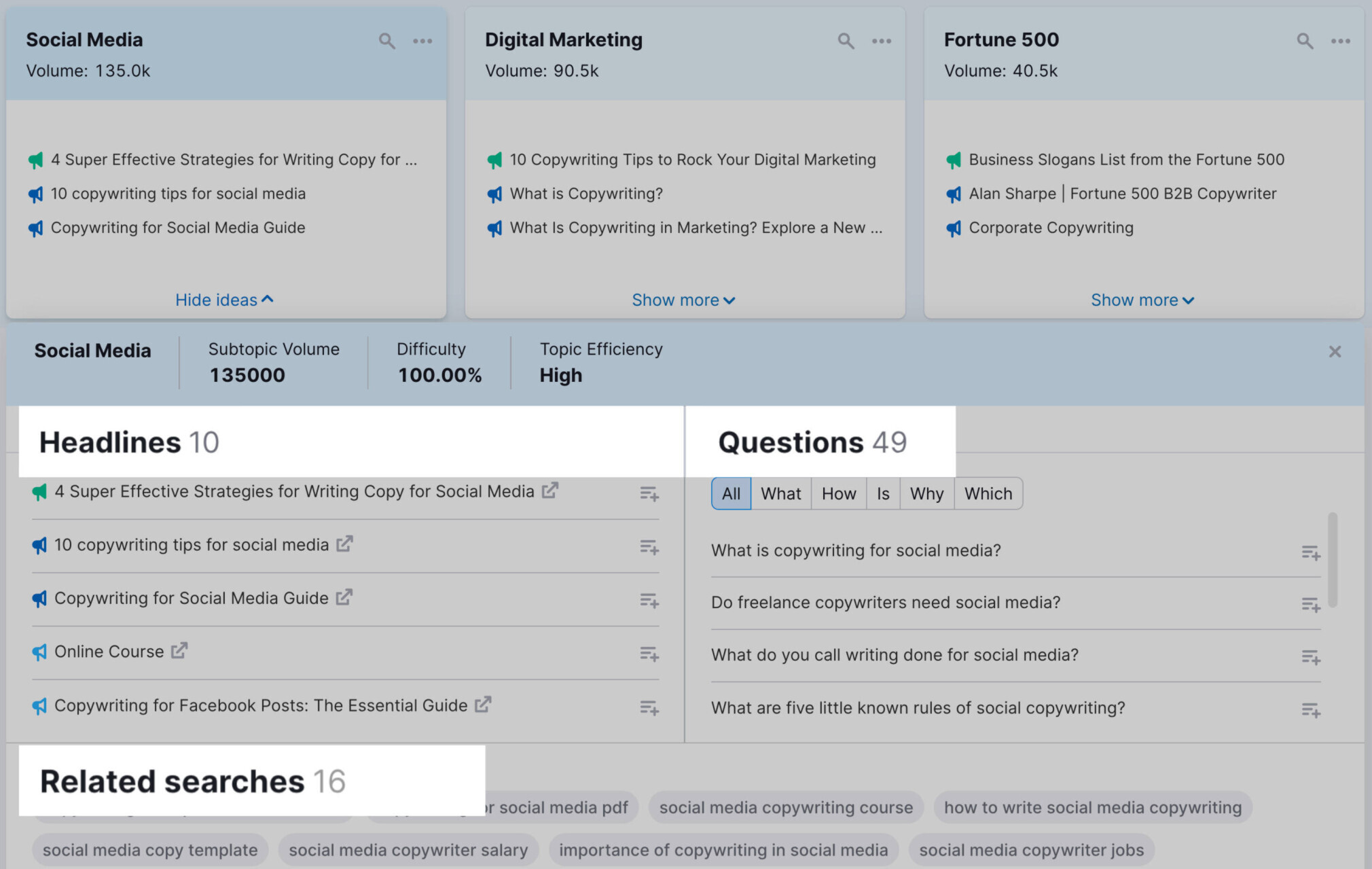
By default, the results you see are all sorted by search volume.
But, you can also choose to sort your topic cards by volume, difficulty, or topic efficiency.
Doing so can help you save time when deciding which card (or subtopic) you want to work from.
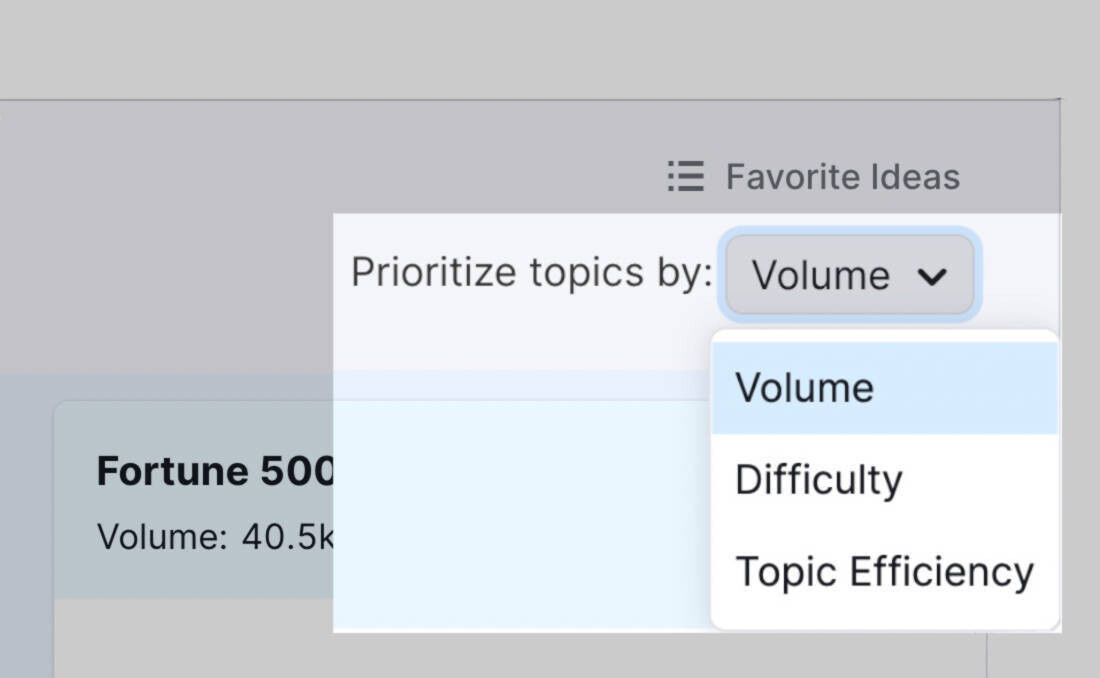
The key in this step is to pick topics that have the potential to unlock more supporting subtopics.
If you pick a narrow topic, you won’t have enough keywords to choose from. Too broad, and you’ll have to filter through too many unrelated terms.
Export the full report for topics that you find interesting and link to it in your template doc.
To learn more about generating content ideas with our Topic Research tool, read our detailed guide.
2. Conduct Keyword Research
The headlines, questions, and related searches above give you useful ideas to start prioritizing the content you should be writing.
It’s still a good idea to dig a little deeper with keyword research.
Conducting keyword research uncovers other useful features like:
Different content formats High-volume question keywords Featured snippet opportunities, and more.Find Different Content Formats
Open up Semrush’s Keyword Magic tool, enter the topic (keyword) you’d like suggestions for, and hit “Search.”

Use keyword modifiers (i.e., a word, or group of words to make your keyword more specific and targeted, like “tips” or “tools”) to drill down and find specific content formats.
Toggle the All tab Select Phrase Match Add modifiers to the Include keywords filter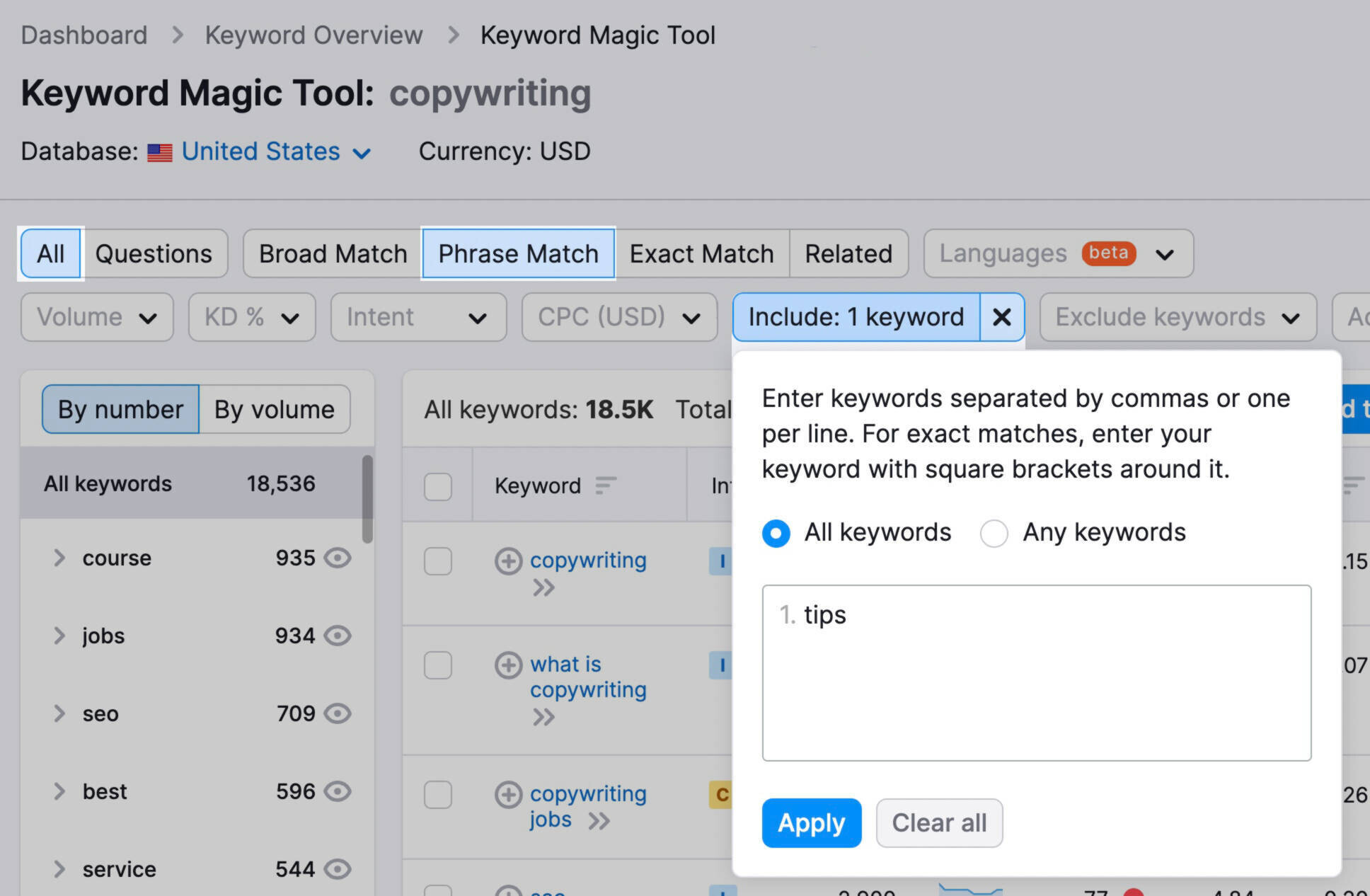
Other formats (modifiers) you can try:
Benefits Best Review ExamplesFind High-Volume Question Keywords
This method is useful for building a list of question-based keywords with a minimum search volume for you to target.
Toggle the Questions tab Select Broad Match Set a minimum Volume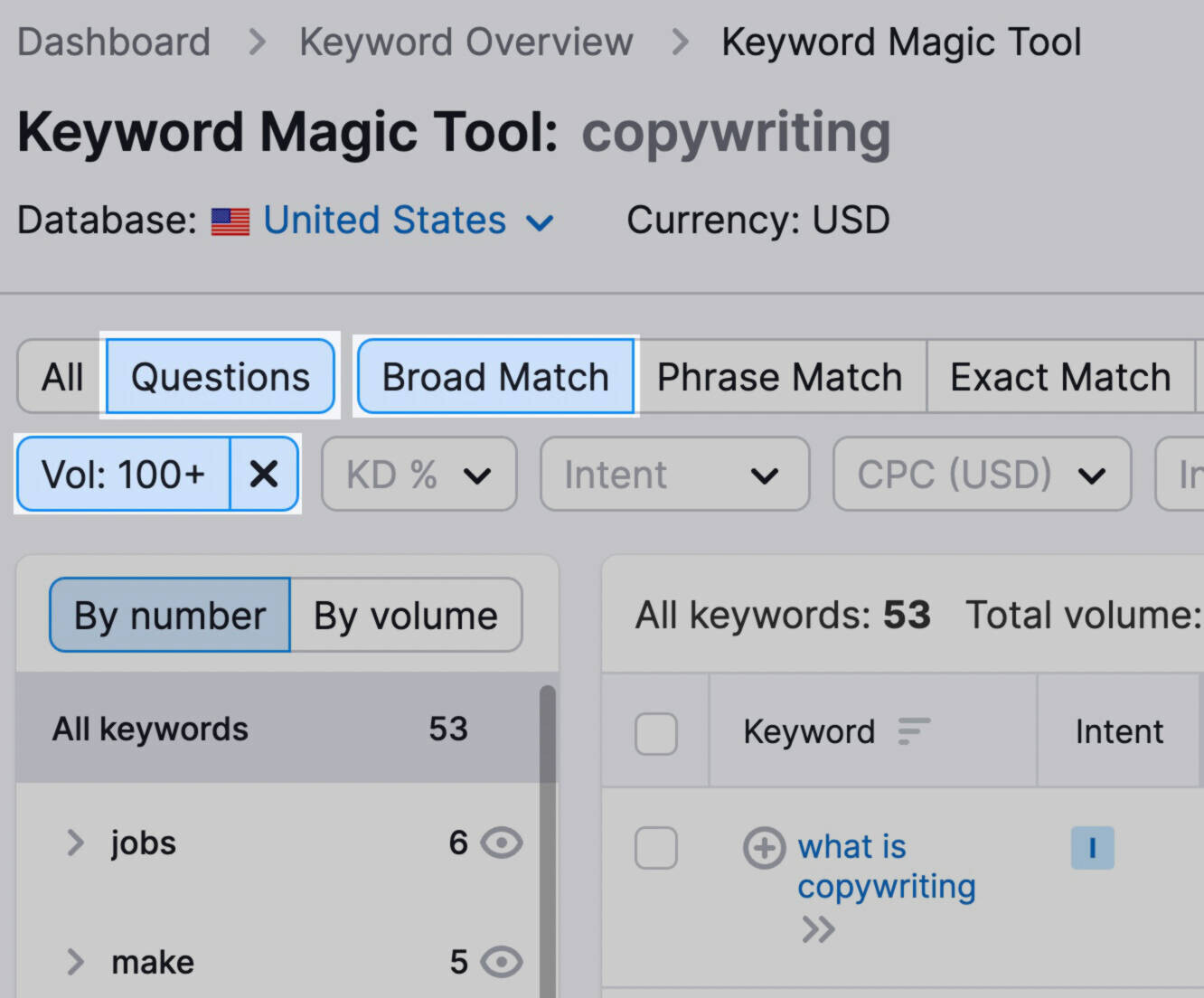
Change the volume number based on your topic or preference. It varies by industry, but you can set it to something general like 100+ searches to start.
Keep in mind that, by default, Semrush sorts results by search volume.
Tip: Combine this process with the Group filter, and you can easily start building out keyword-focused FAQ pages per term.
For example, when we filter the “freelance” group, we get three questions.
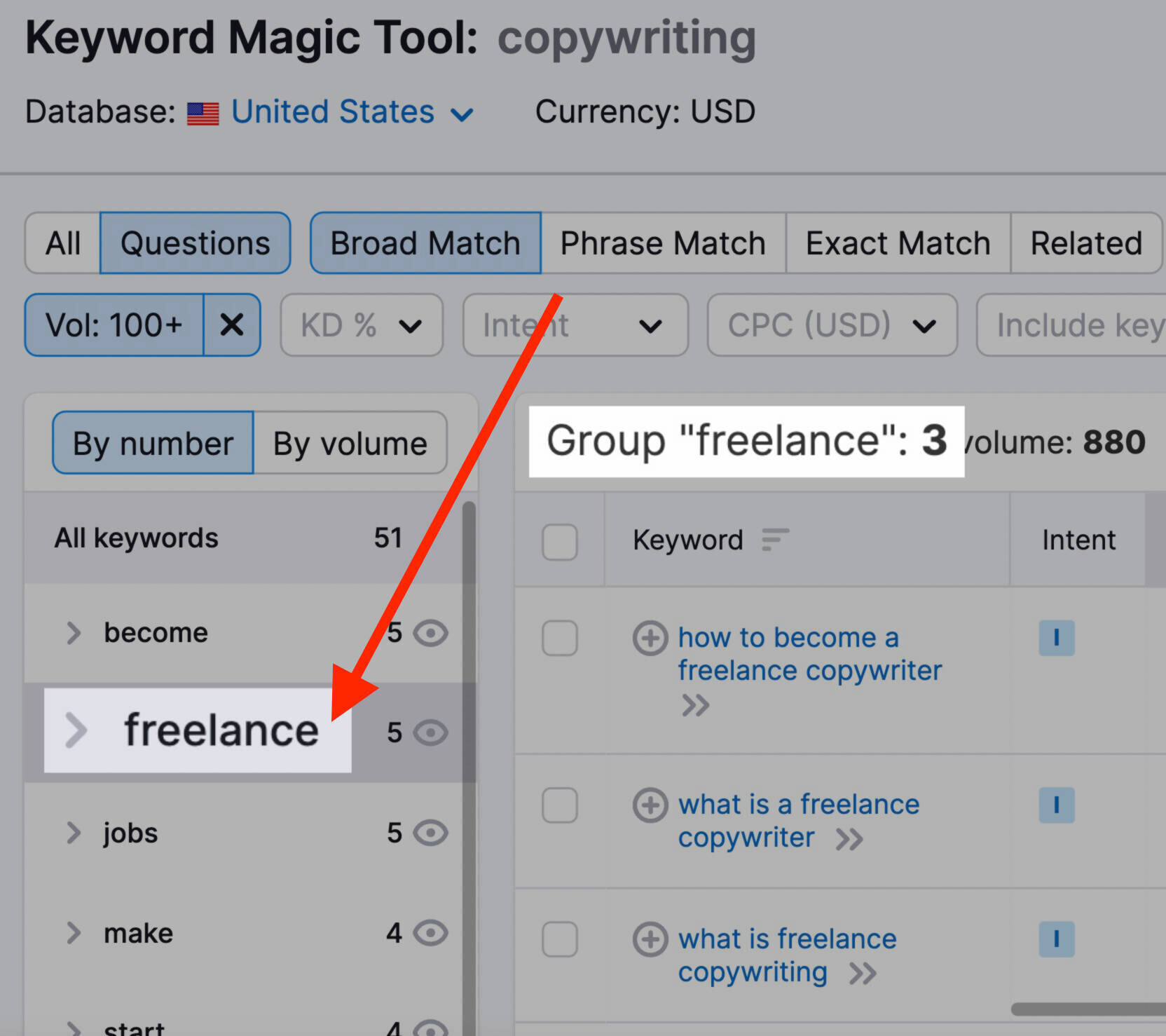
All with good search volume and informational intent (looking to learn more). Perfect.
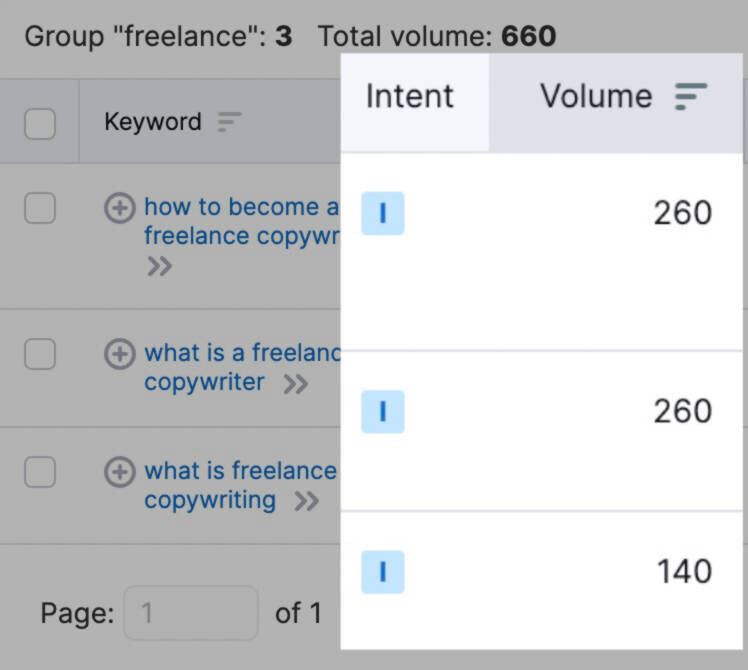
Find Keywords That Trigger Featured Snippet Opportunities
Featured snippets are small excerpts that appear at the top of Google’s search results in order to quickly answer a searcher’s query.
Common types of featured snippets include definitions, tables, steps, and lists.
Here’s an example of what an ordered list snippet looks like:
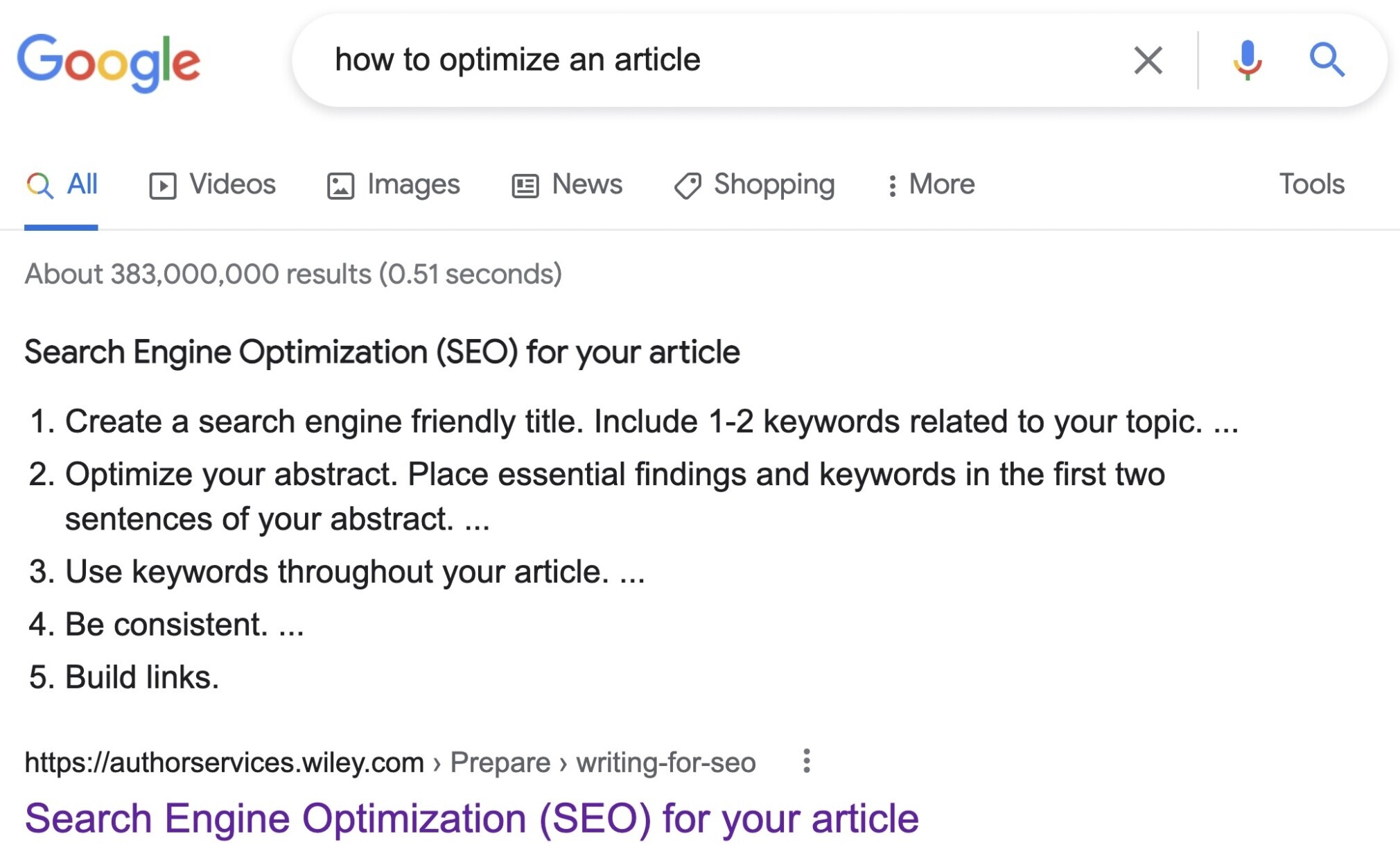
Since featured snippets typically appear in informational search results, this tactic is a quick way to uncover the types of keywords that work well as informational content.
Toggle the All tab Select Phrase Match In Advanced filters, select all SERP Features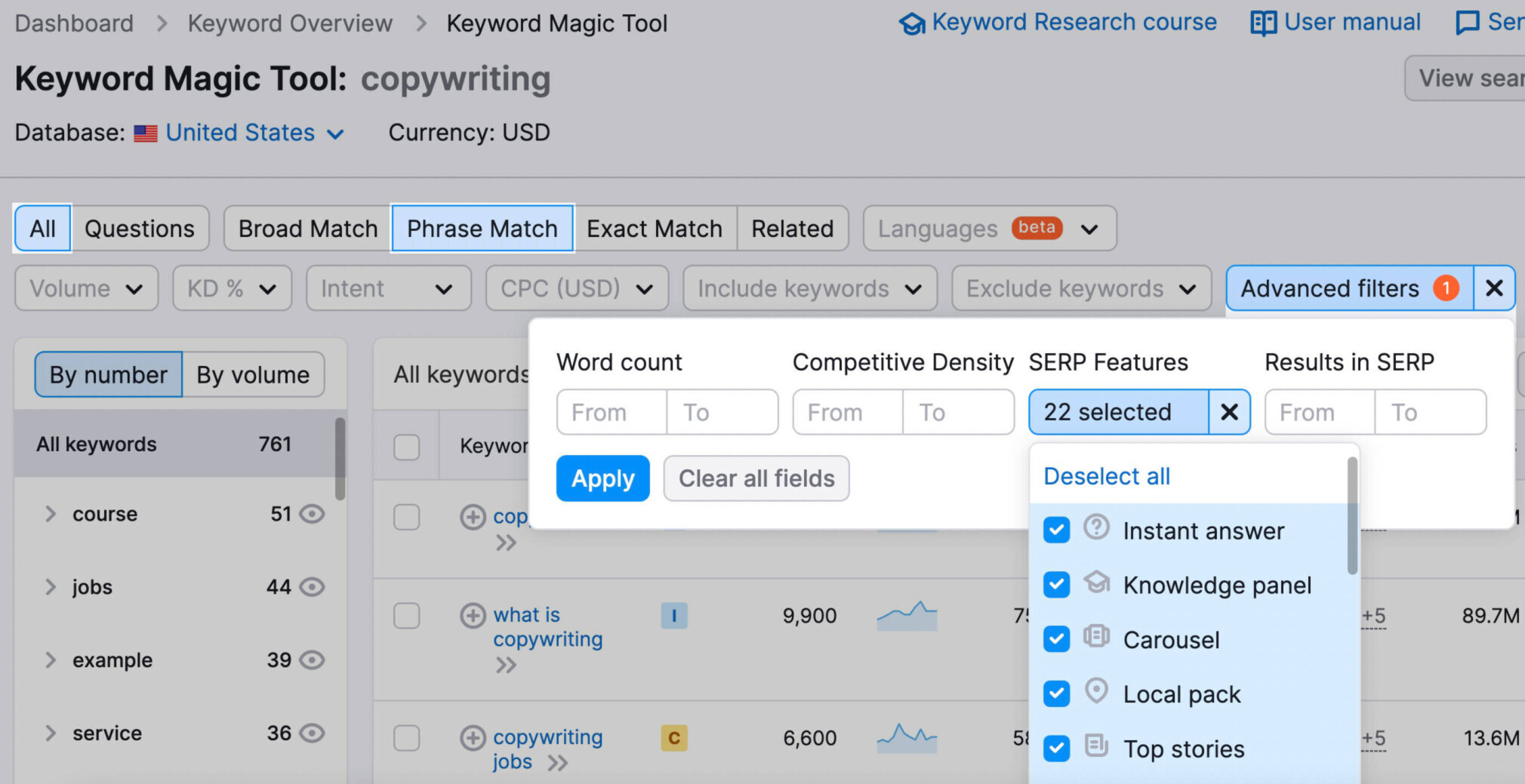
This step helps show terms you may have missed outside of question-based keywords.
3. Outline Your Pillar (Topic) & Cluster Structures
After researching keywords, you’ll need to outline what your pillar and topic clusters will look like.
Your pillar page should link to your subpages, and your subpages should link back to your pillar page. This creates an organized site structure, which helps Google better crawl your site and determine subject matter.
Google understands subtopics around a broad interest, so clusters mirror Google’s AI direction.
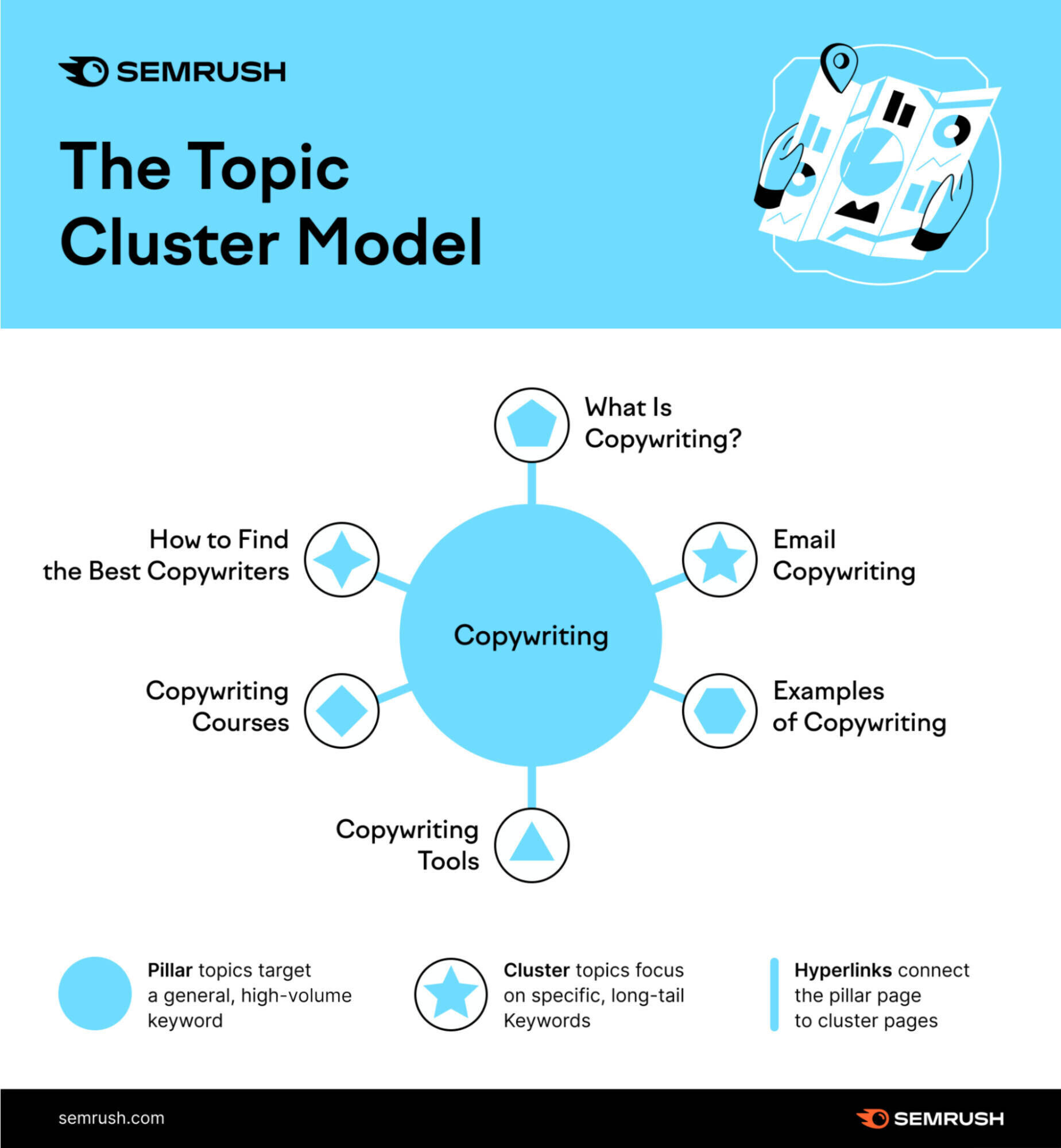
Outlining your cluster model helps you see your content at a high level and organize it all—what you already have and need to write.
Make a big circle with all your topics (pillars) and smaller circles around it with all the subtopics you’ve uncovered.
Start by leveraging your existing content, and then fill in the blanks.
Step #6. Improve Your On-Page SEO
On-page SEO is the practice of optimizing your web content for search engines and users.
Getting your on-page SEO right is fundamental for your SEO strategy because it still plays a major role in Google’s ranking factors.
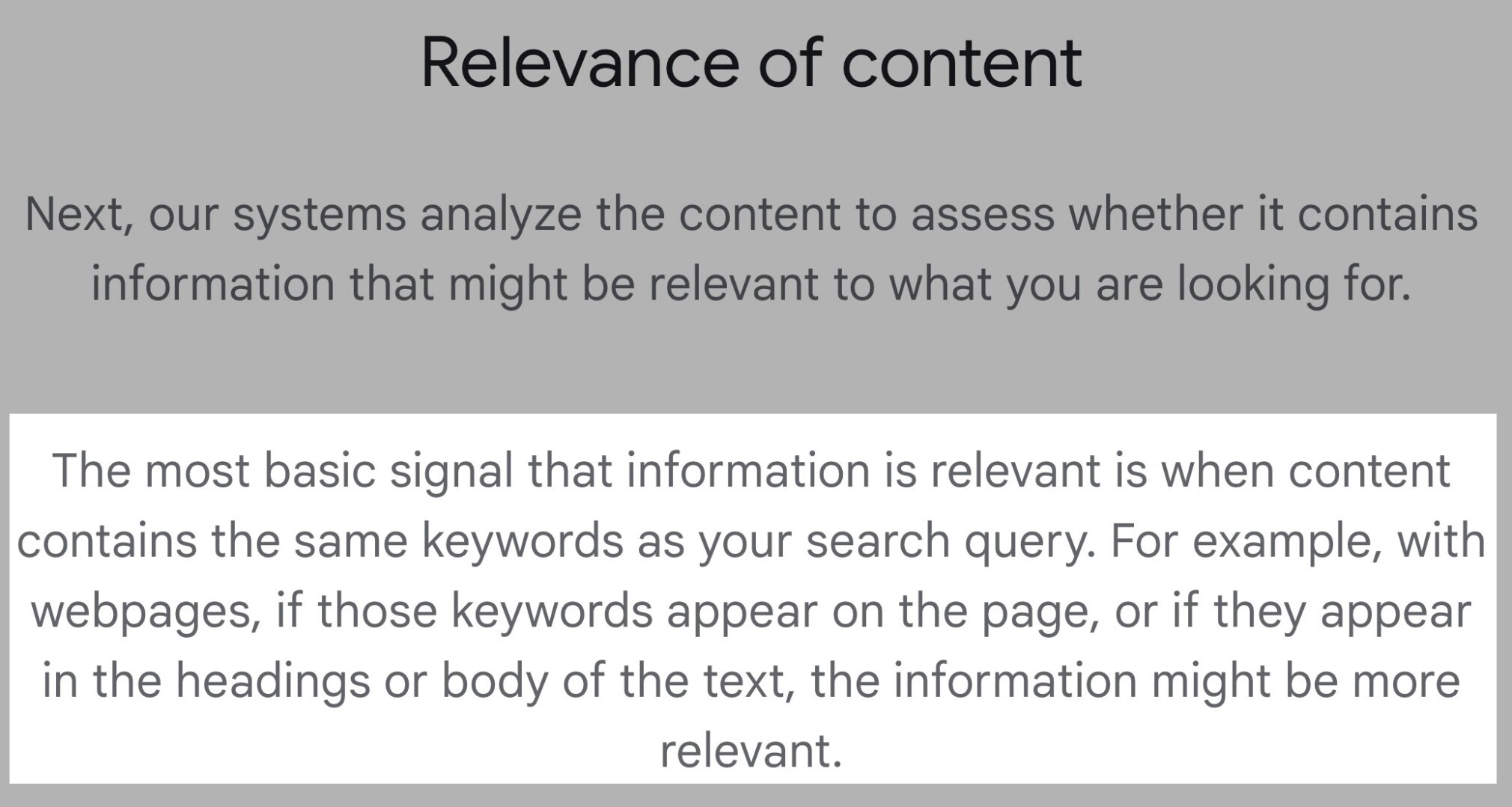
Even though Google is much smarter than it was before, it still heavily weighs traditional SEO elements (like looking for a specific keyword on your page).
Common on-page SEO practices include revising:
Title tags Meta descriptions Headings Internal links URLsA great way to audit your website’s on-page SEO is to run it through an SEO tool.
Let’s see what that looks like using Semrush’s On-Page SEO Checker. Enter your domain, and you’ll see a dashboard that displays the “Overview” report.
On this page, take a look at three things:
The total number of suggested on-page ideas The estimate of how much traffic you can gain by implementing them The list of pages to optimize first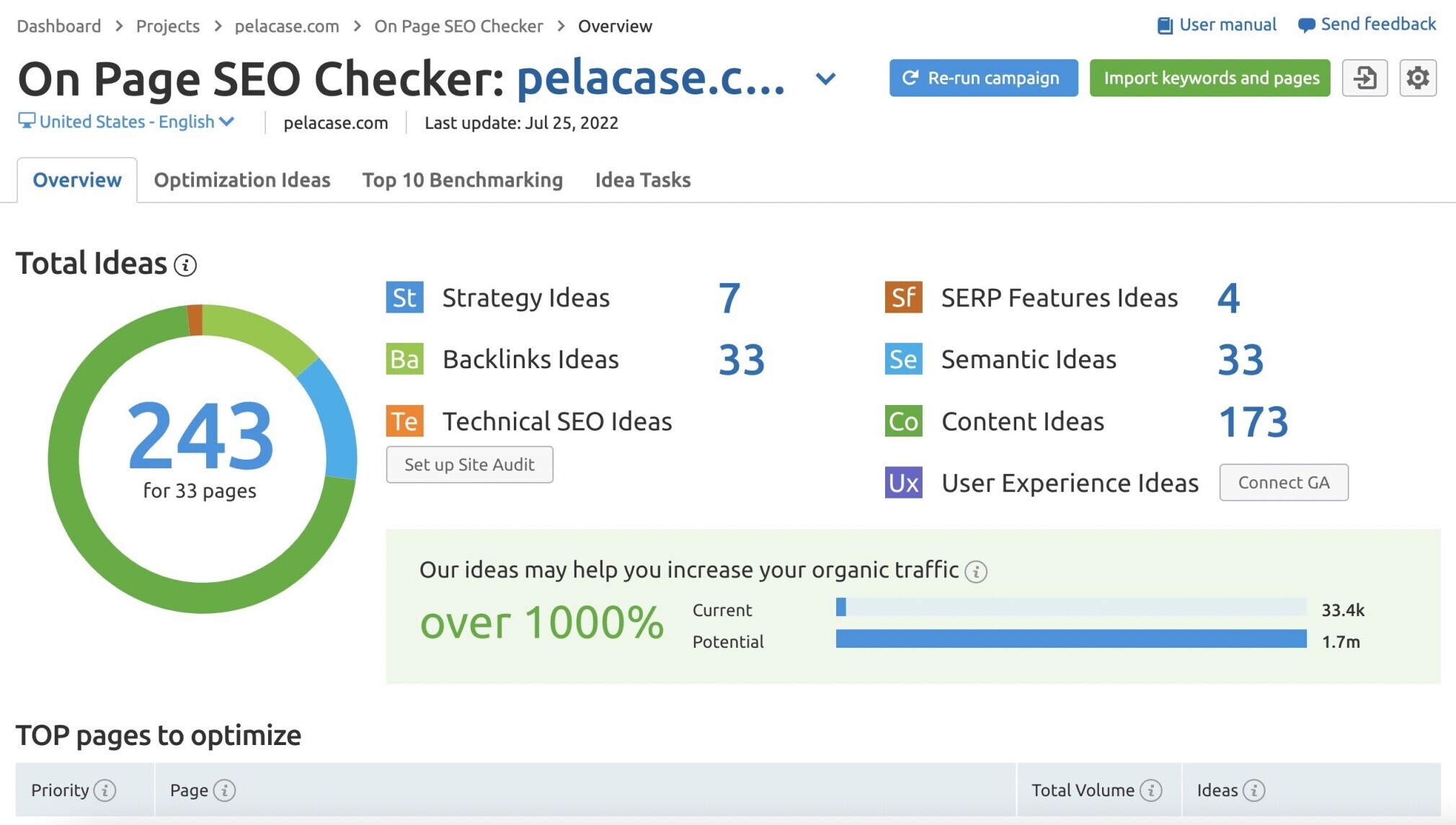
At the top of the Overview, you’ll see the total number of ideas (243) conveniently broken down into categories, including:
Strategy Ideas (find which pages perform best and optimize their on-page SEO for quick wins) Backlink Ideas (build an outreach list and backlinks from highly-trusted websites) Technical SEO Ideas (view data from the Site Audit tool that shows the technical issues your website has) User Experience Ideas (analyze data from Google Analytics to help you know what you need to fix to improve your UX and rankings) SERP Features Ideas (analyze the keywords triggering SERP features and make recommendations you can implement right away) Semantic Ideas (find related keywords you can add to enrich your content) Content Ideas (analyze competitor content and get actionable advice you can implement to your pages to outperform your competitors)Click on each one to see what you can do to improve your site’s on-page SEO immediately.
Alternatively, you can view all of the ideas in a table.
For example, the “Optimization Ideas” tab shows a table with all your landing pages, their corresponding target keywords, and total volume.
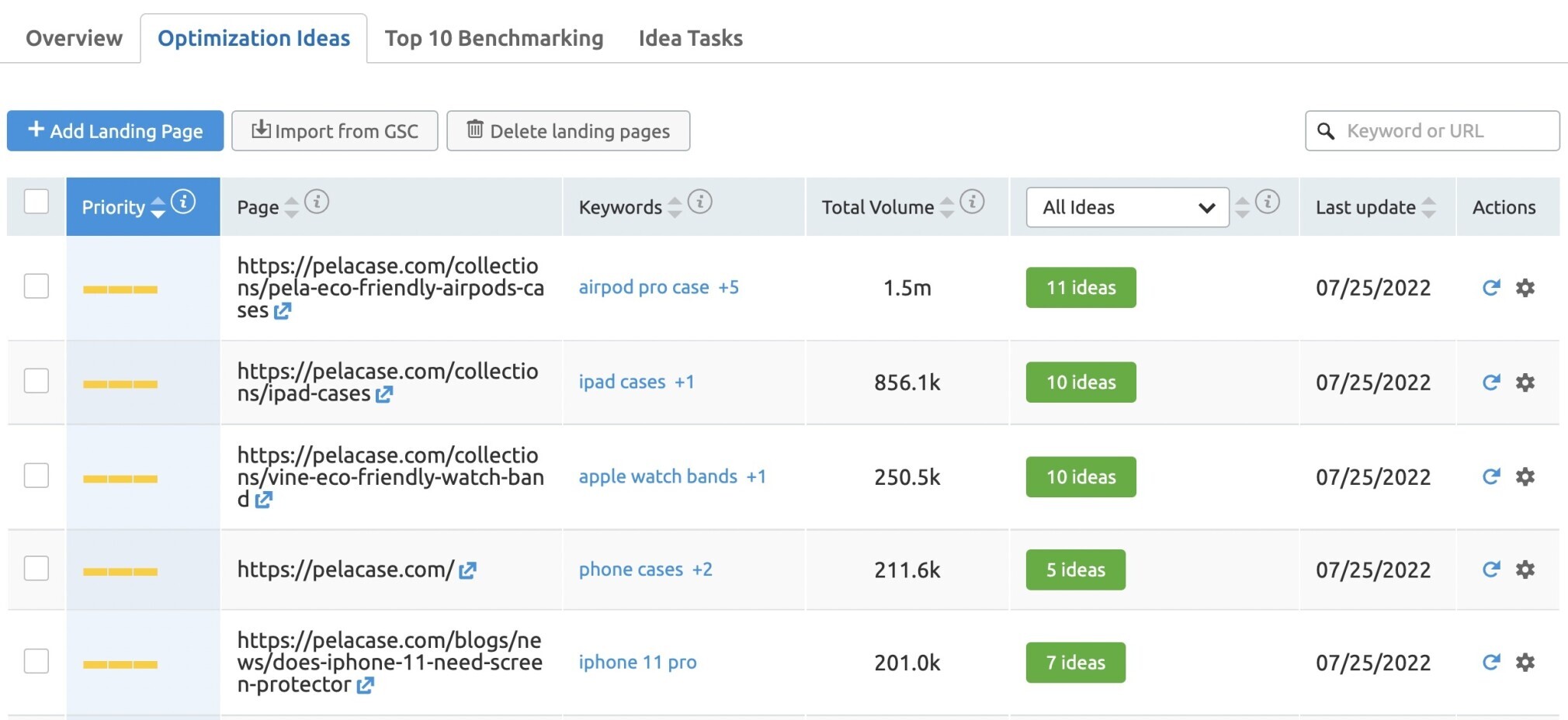
Note: The volume represents the sum of the monthly search volumes between all of the keywords targeted by each page.
You can sort the table by priority, URL, keywords per page, total volume, total number of ideas, or last update. Simply click on the corresponding column.
To inspect an idea further, click on the green button with the number of ideas in the row of the page you wish to optimize.

Note: If we find that a page is already optimized, the tool won’t provide ideas to optimize it.
You’ll be able to see a report with all of the ideas for that particular URL.
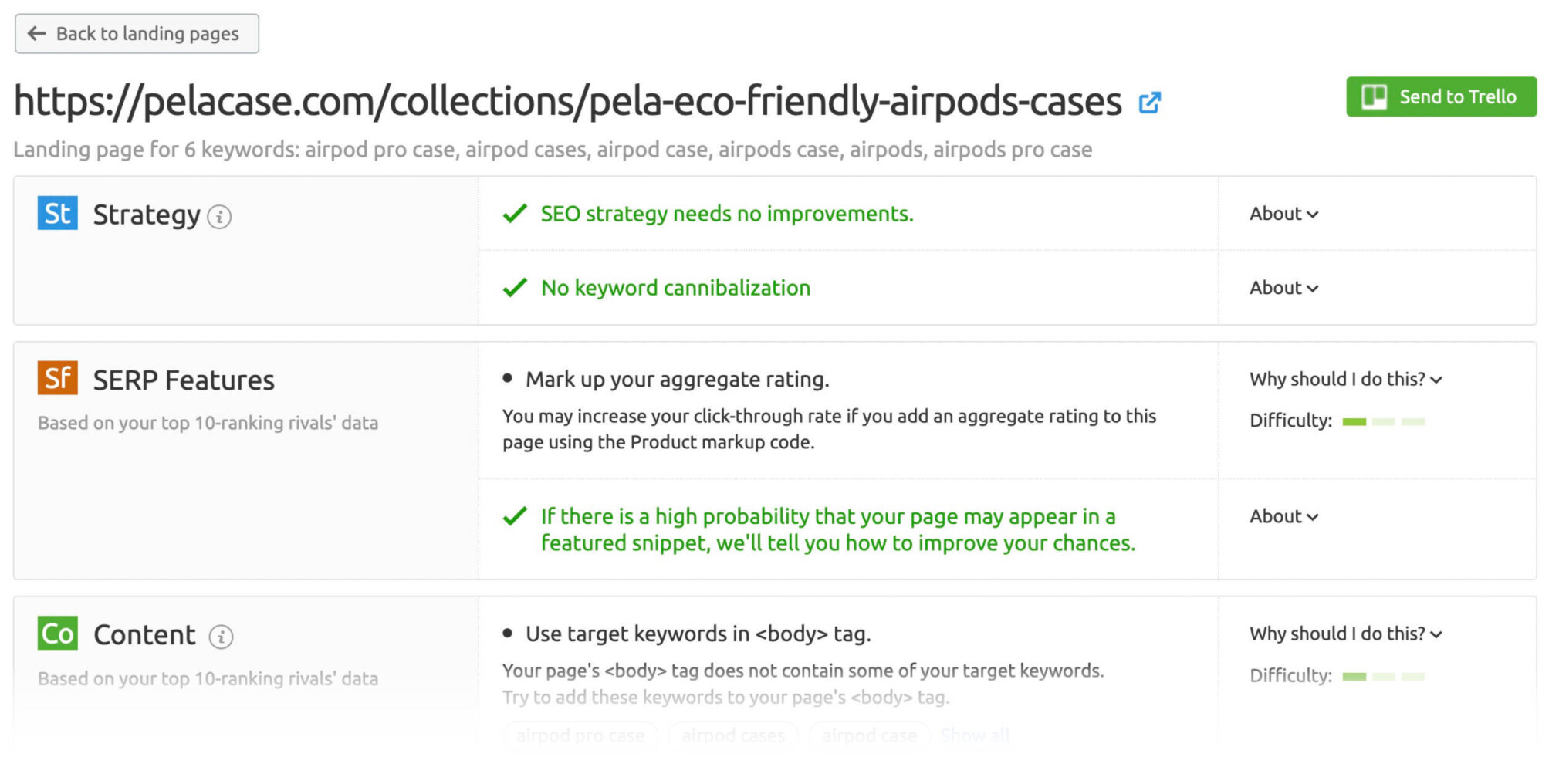
You can now see exactly what each suggested idea recommends and why.
Click on the arrow beside “Why should I do this?” in the third column to read the reasoning behind its SEO value.
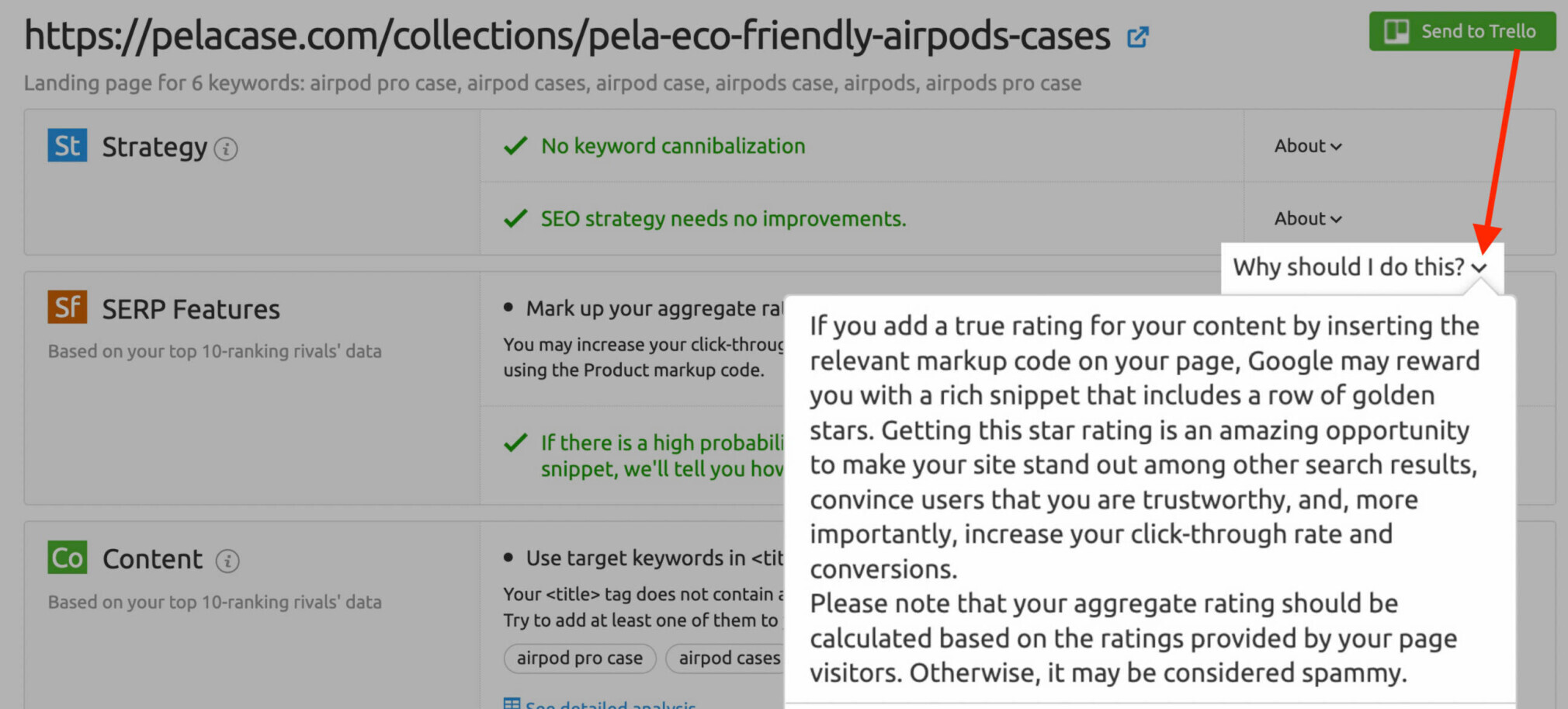
If you use Trello for task management, you can send an idea to your Trello board as a new card by clicking on the green button at the top right.

As another option, you can export a spreadsheet (.xlsx file) with each of the different types of ideas. The export button is next to the Settings gear at the top right of the dashboard.

A spreadsheet helps you sort your to-do list outside of Semrush.
If you work on a team, you can divide and conquer the ideas by category among team members.
For example, you can provide your list of backlink ideas to your link-builder, content ideas to your content writer, technical SEO ideas to your developer, and so on.
Make sure to add a link to the full export to your template doc so you can easily locate it.
For more details about on-page SEO and advanced on-page SEO tactics, read our in-depth guide.
Step #7. Find & Fix Technical SEO Issues
Technical SEO is the process of optimizing your website to help search engines find, crawl, understand, and index your pages.
The easier you make it for search engines like Google to access your content, the better chance you have to rank.
But, technical SEO isn’t just crawling and indexing.
To improve your site’s technical optimization, you need to take into account other factors like:
Javascript XML sitemaps Site architecture URL structure Structured data Thin content Duplicate content Hreflang Canonical tags 404 pages 301 redirectsAnd more.
You can use Google Search Console to help monitor and troubleshoot your website’s appearance in search results.
To do so, go to the “Core Web Vitals” report under “Experience.”
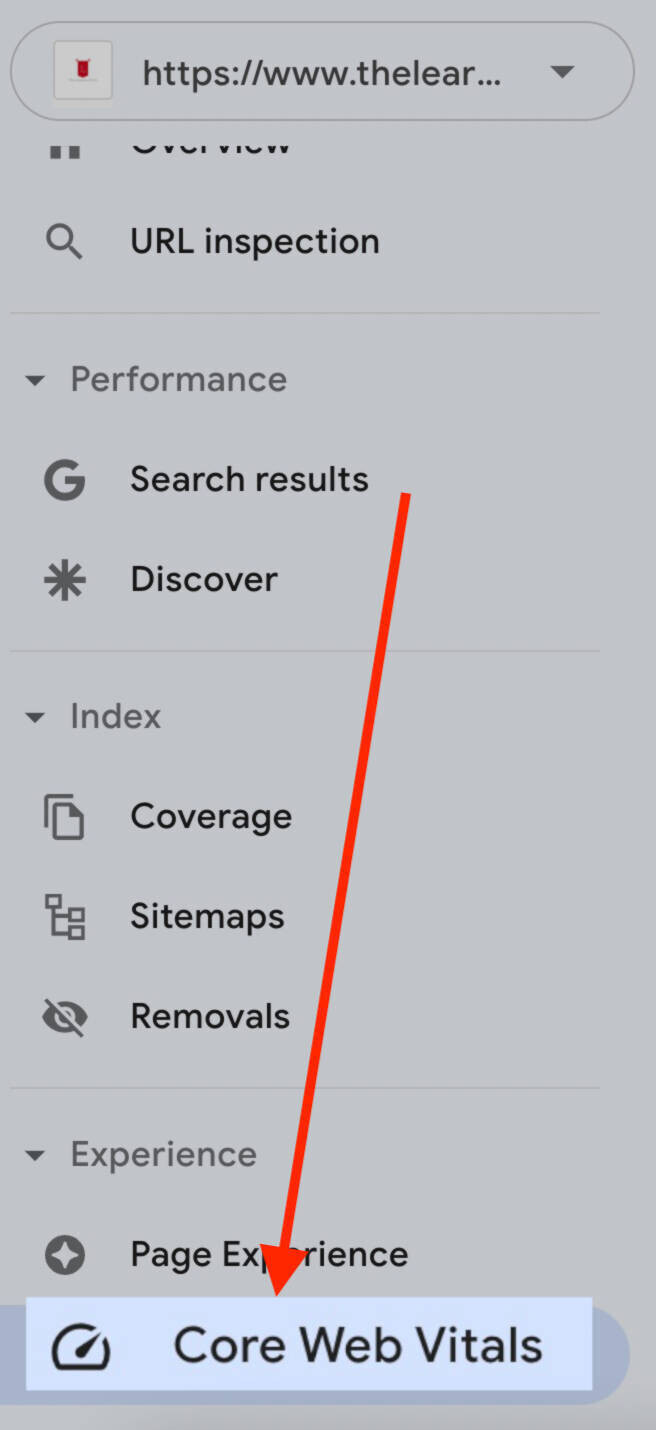
You should see a report for different devices, telling you which URLs you need to improve.
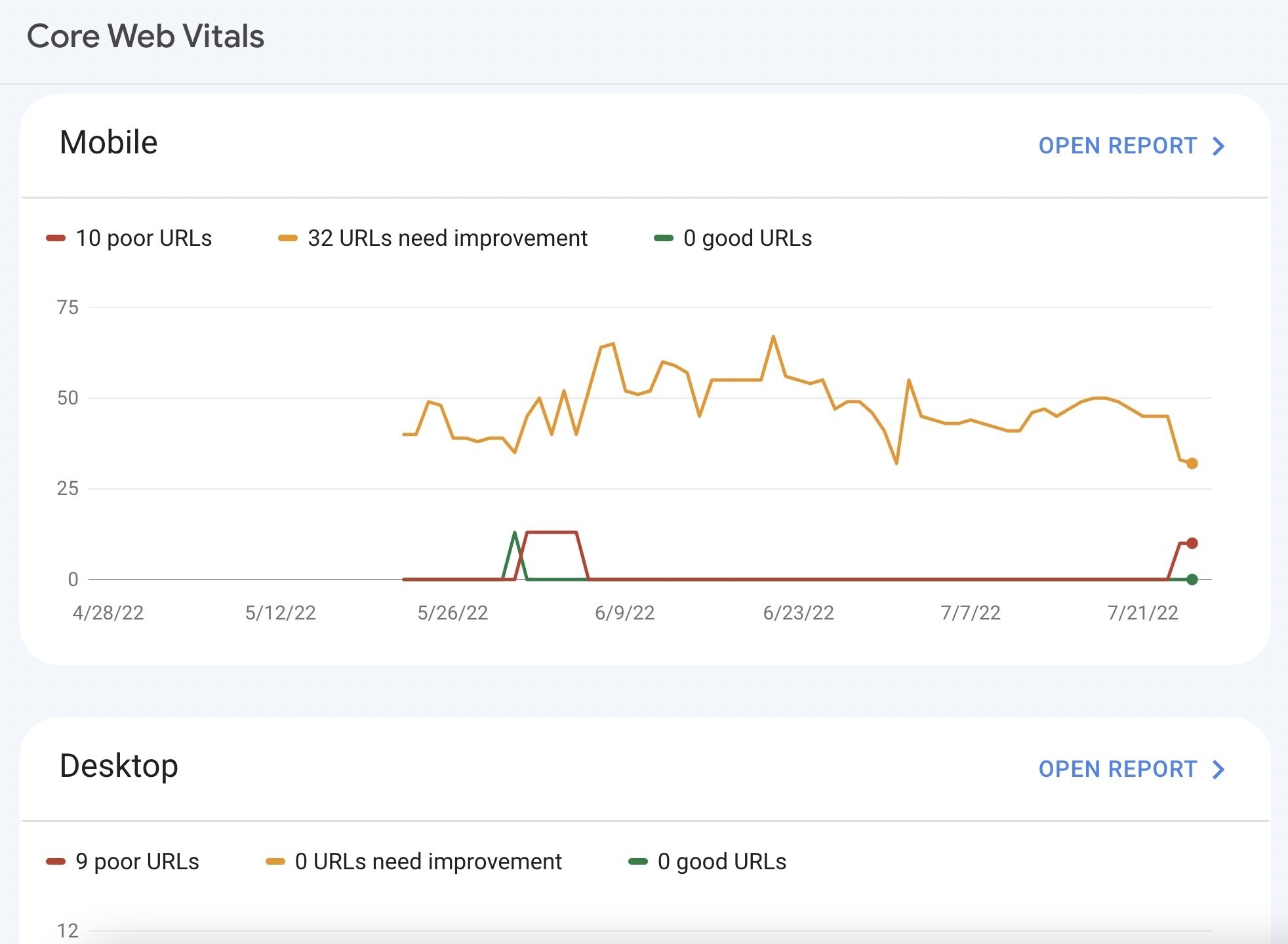
Bing and Yandex have their own tools to find and fix technical issues, and so does Semrush.
Site Audit is a free tool (up to 100 pages) that scans your website for technical and SEO mistakes.
It allows you to monitor your site’s SEO health and check for 140+ SEO issues, including:
Slow load speed Oversized HTML Redirect chains and loopsIn this case, we only want to see the technical errors, so we’ll click on Errors.
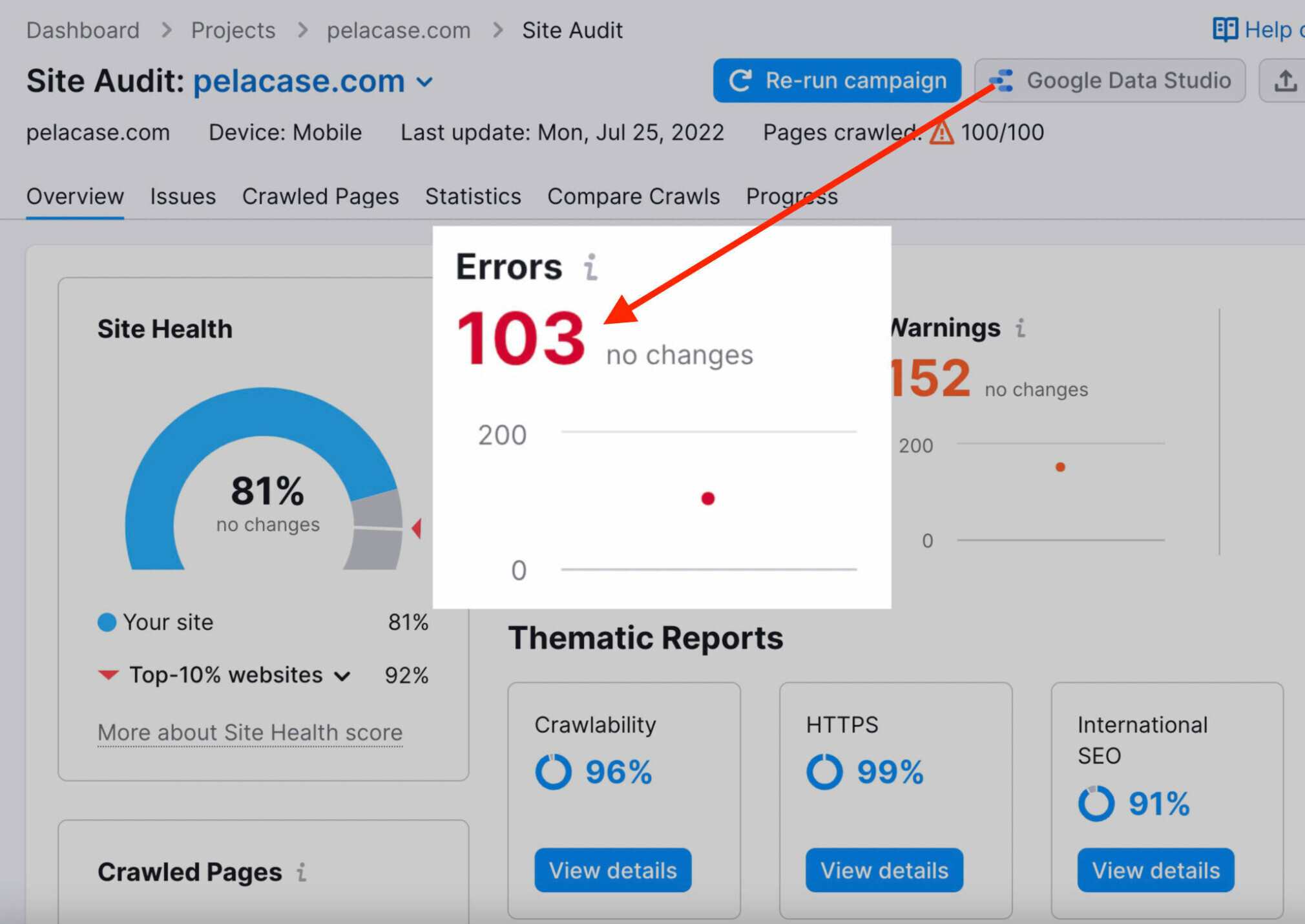
The tool displays a list of all your errors, explaining each issue and how to fix it.
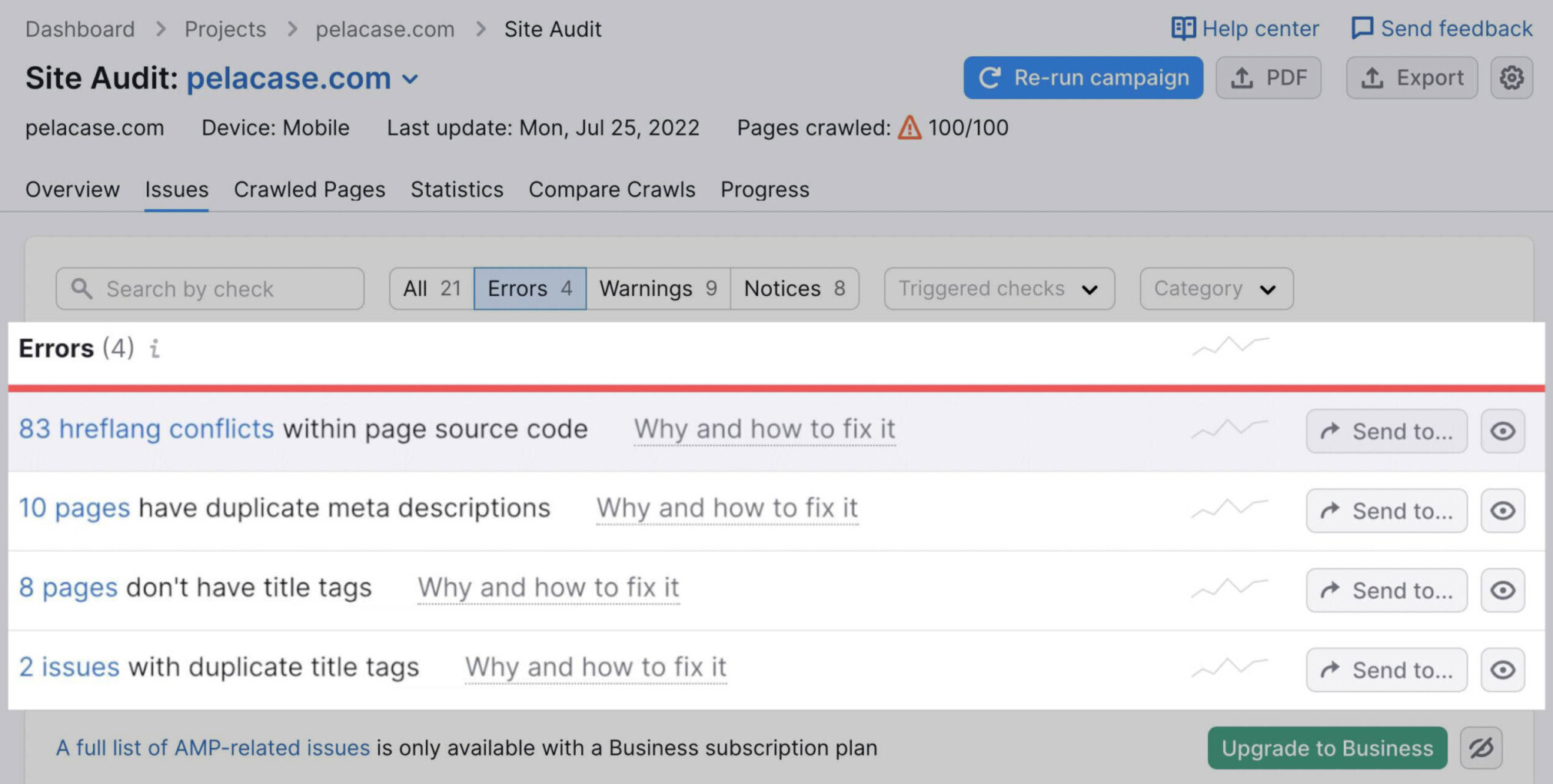
Export the full report of all the issues and add it to your template doc.
Start working through the errors first (issues with the highest severity) and then move on to the warnings and notices.
Note: Technical SEO errors tend to be quite advanced, so you might need your developer’s help to fix the issues.
We recommend running periodic scheduled audits (monthly) to notify you of any new issues that need your attention before they become a more serious problem.

If you want to learn more about technical SEO, we recommend looking at our guide to getting started.
Step #8. Work on Your Off-Page SEO
Off-page SEO refers to actions taken outside your website that impact your rankings.
Common off-page SEO actions include:
Building backlinks Encouraging branded searches Increasing engagement and shares on social mediaBut, above all else, building backlinks is at the heart of off-page SEO.
Search engines use backlinks to determine the quality of the linked-to content, so a site with many high-value backlinks will usually rank better than a similar site with fewer ones.
Generally speaking, there are three ways to get more backlinks:
Create backlinks by manually adding links to your site from other websites Earn backlinks by creating useful content people want to link to Build backlinks by reaching out to other site owners, editors, or web admin and asking them to link to your siteCreating and earning backlinks are fairly straightforward, but building backlinks takes a lot of work and patience.
A great way to get started is to use Semrush’s Link Building Tool.
Enter your domain, and the tool starts collecting and analyzing data from your competitors and most important keywords.
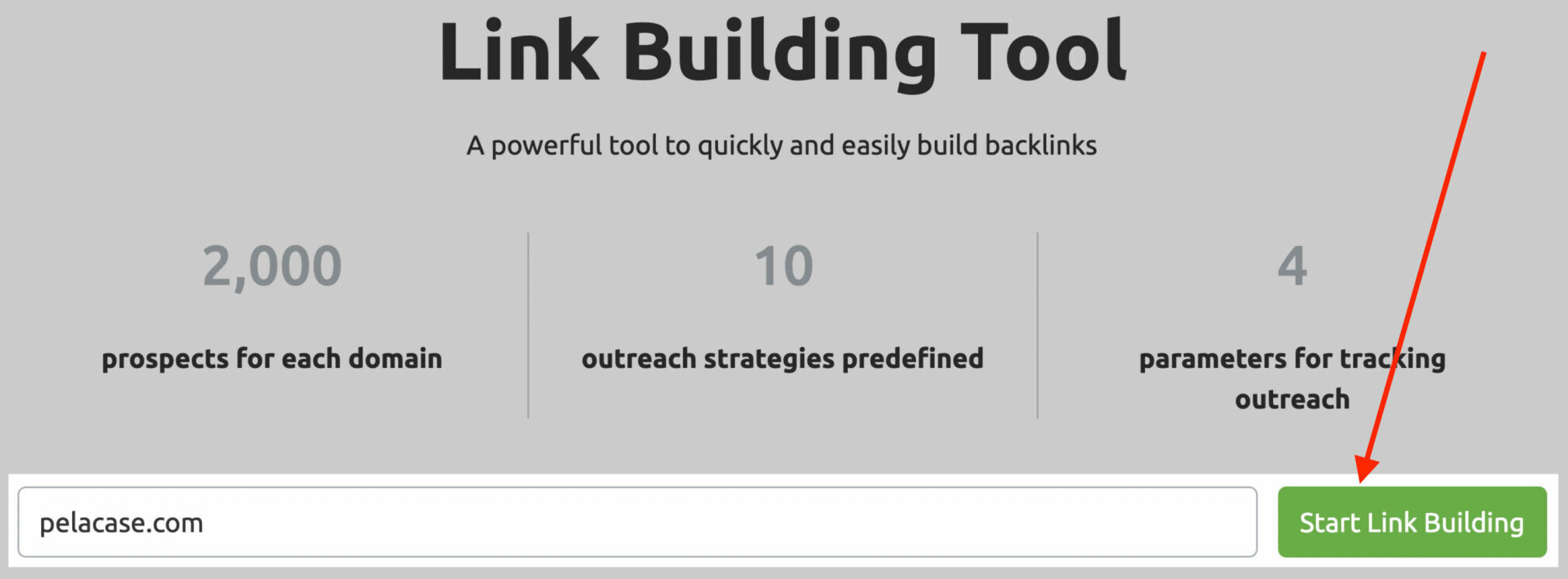
After a few minutes, it’ll display a list of prospects you can reach out to for backlinks.
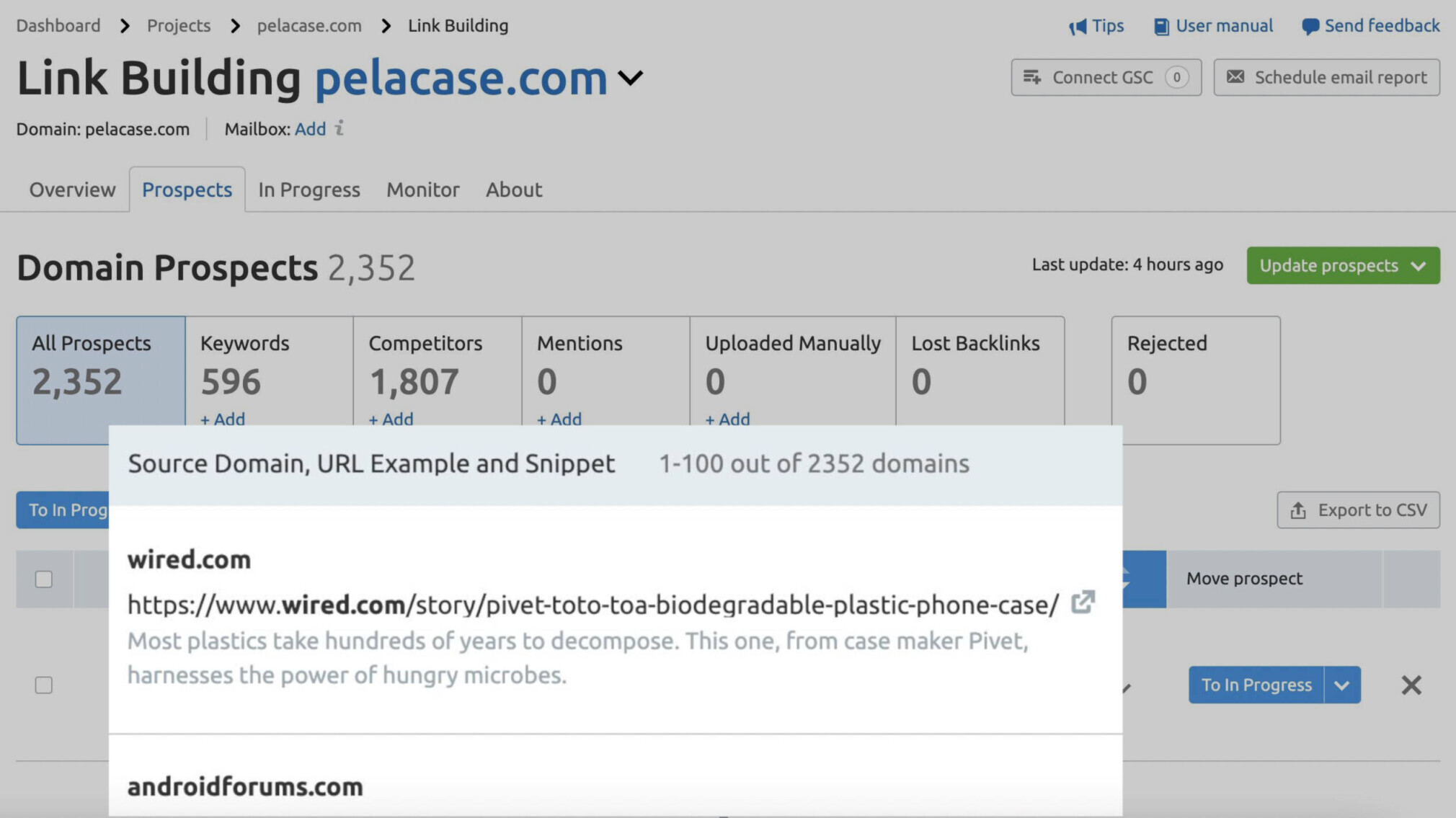
You have two options to get started with your link-building campaign:
Download the report as a CSV to prioritize your efforts and keep track of your progress (and link to it in your template) Use the tool’s management interface to run your outreach campaignIf you opt for option two, you can easily reject the prospects you don’t like by clicking the “X” and move forward with prospects you want by clicking the “To In Progress” button.

Then, from the “In Progress” tab, you can reach out to your prospects via a connected email account by clicking the “Contact” button.
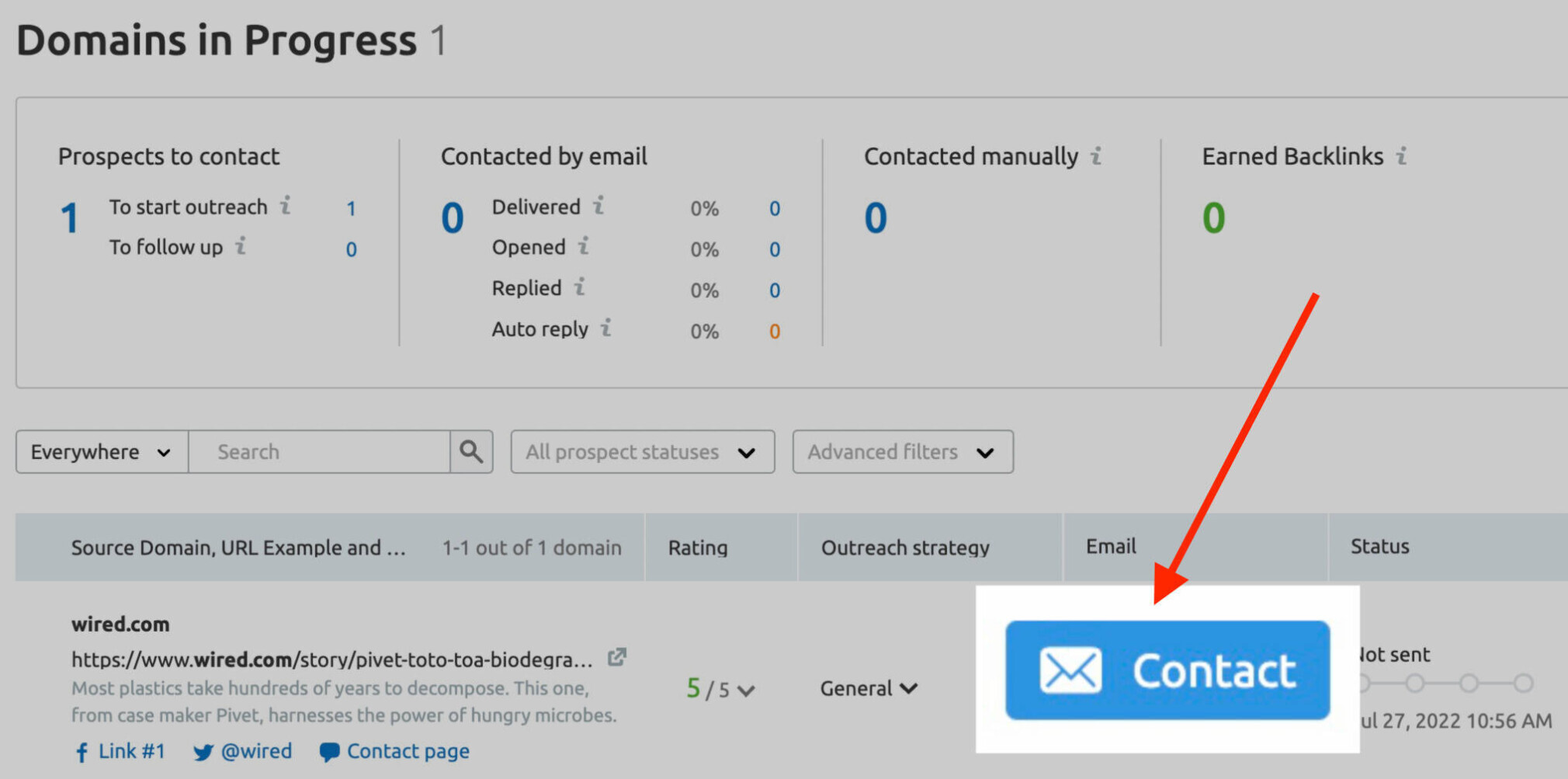
The tool suggests the number of emails you should send to each prospect and offers recommendations for the email copy.
To see what that looks like, click on the “Contact” button.
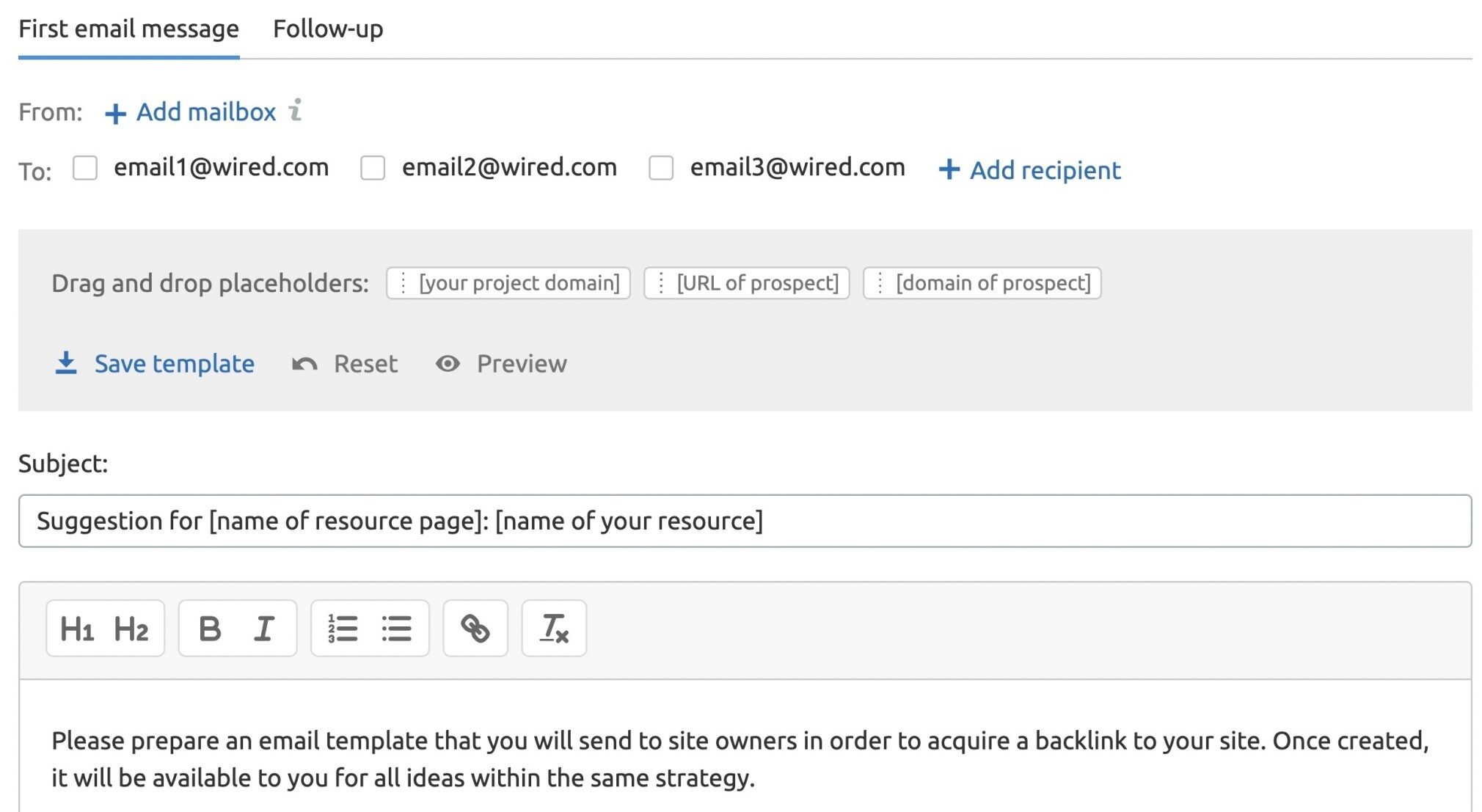
The tool automates the email with default information, but you can (and should) customize them to make your pitch specific to your campaign.
You can:
Choose which emails to send your pitch to; Drop placeholders for automated items like the prospect URL and your domain, and; Add formatting such as bold text, lists, and headers to your email.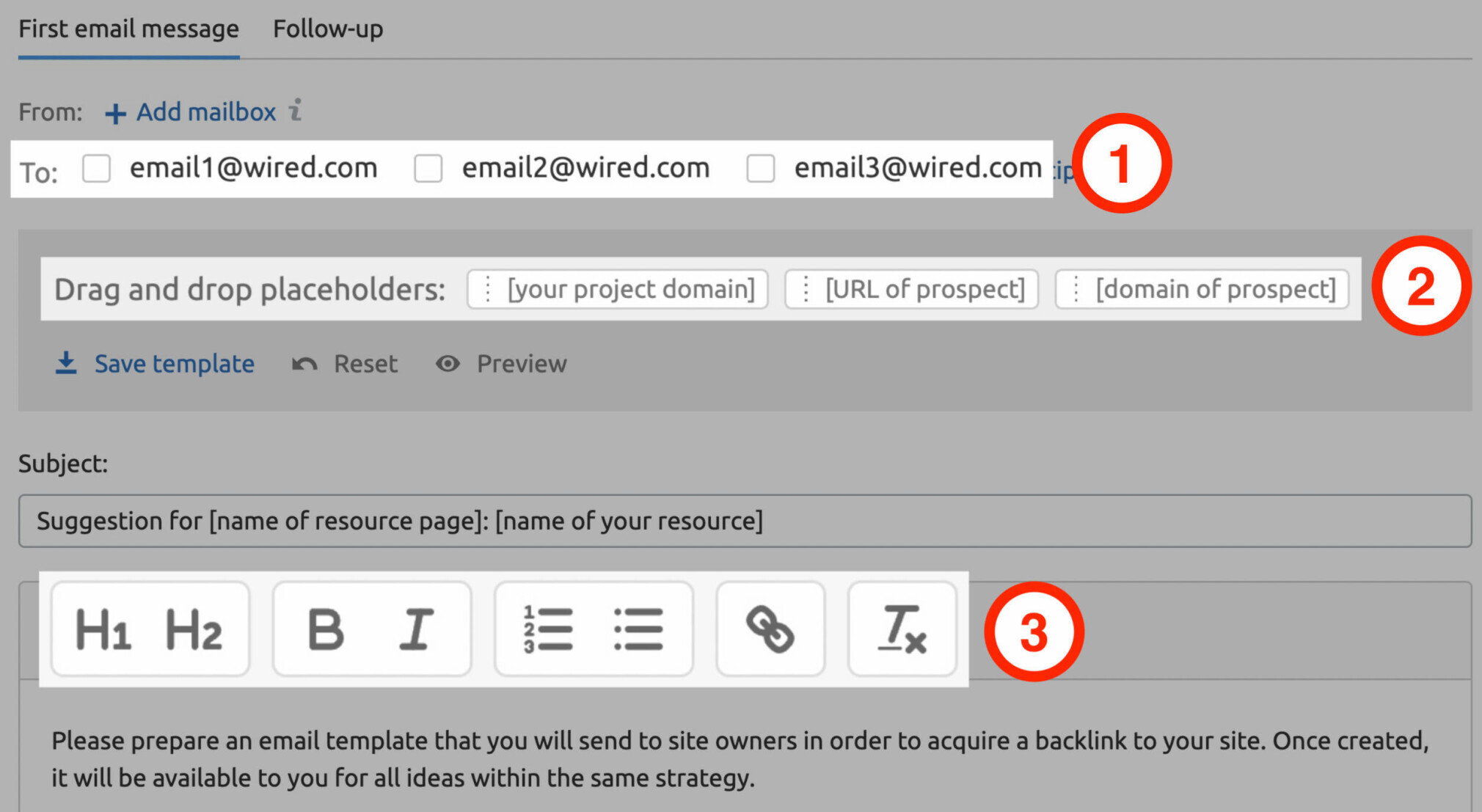
Once you’re finished, click “Send” and you’ll move on to the next domain without ever leaving this screen.
This is a simple and effective way to start building high-quality backlinks.
To read more in-depth about off-page SEO, check out our comprehensive guide.
Analyze & Refine Your Strategy
Ranking in Google is a bit of a juggling act.
As you optimize and try to rank for one keyword, your rankings for other keywords often start to drop.
That’s why no SEO campaign is ever “finished.” All SEO strategies should be cyclical.
You have to rinse and repeat and continuously evaluate your work. There are always opportunities to continue to drive growth.
Remember when you set your goals and KPIs?
Measure and report on your KPIs (at least every month) to make sure your progress is on track to meet your goals.
Innovative SEO services
SEO is a patience game; no secret there. We`ll work with you to develop a Search strategy focused on producing increased traffic rankings in as early as 3-months.
A proven Allinclusive. SEO services for measuring, executing, and optimizing for Search Engine success. We say what we do and do what we say.
Our company as Semrush Agency Partner has designed a search engine optimization service that is both ethical and result-driven. We use the latest tools, strategies, and trends to help you move up in the search engines for the right keywords to get noticed by the right audience.
Today, you can schedule a Discovery call with us about your company needs.
Source:





